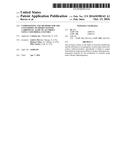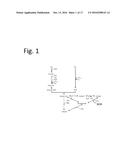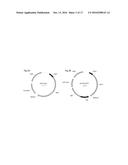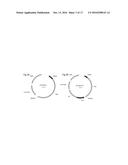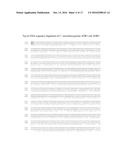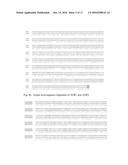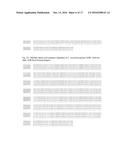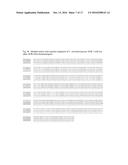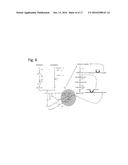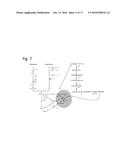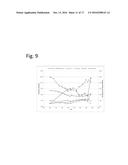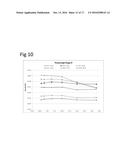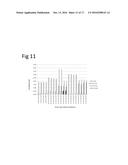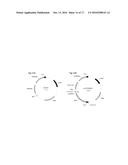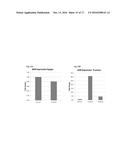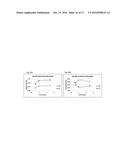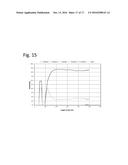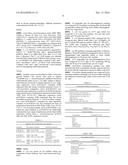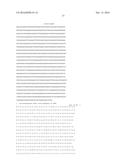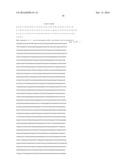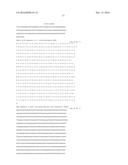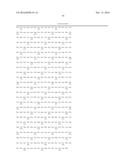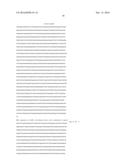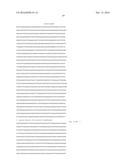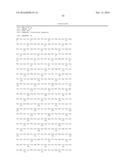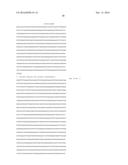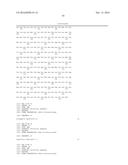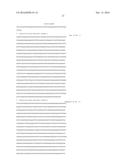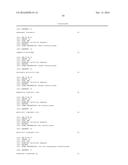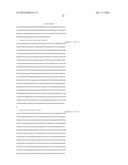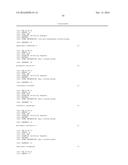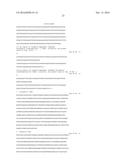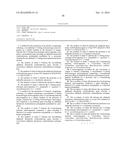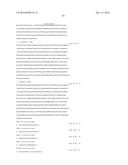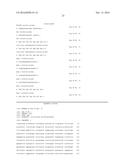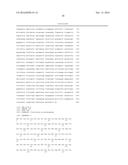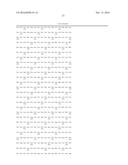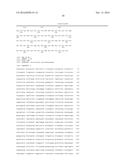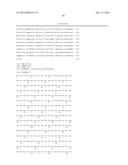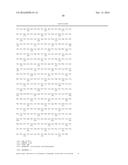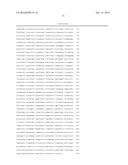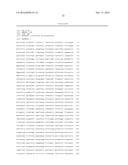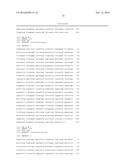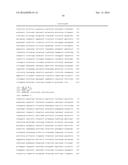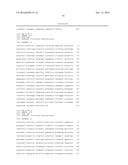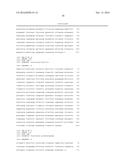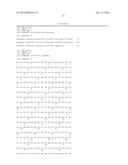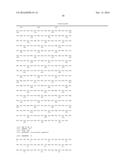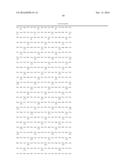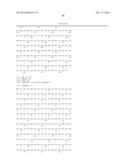Patent application title: Compositions and Methods for the Conversion of Short-Chained Carboxylic Acids to Alcohols Using Clostridial Enzymes
Inventors:
Andrew Reeves (Chicago, IL, US)
Andrew Reeves (Chicago, IL, US)
Richard Tobey (St. Charles, IL, US)
Mike Enzien (Lisle, IL, US)
IPC8 Class: AC12P716FI
USPC Class:
1 1
Class name:
Publication date: 2016-10-13
Patent application number: 20160298143
Abstract:
The invention relates to the fields of bacterial metabolism and the
utilization or consumption of short-chain carboxylic acids to reduced
products. Specifically, it relates to syngas fermentations using
monocultures of syngas-utilizing homoacetogenic bacteria for the
production of alcohols using native alcohol dehydrogenase.Claims:
1. A method for the production of an alcohol, comprising: culturing a
recombinant C1-fixing homoacetogen microorganism in a culture medium in
the presence of syngas, wherein the C1-fixing homoacetogen microorganism
comprises a recombinant gene encoding an aldehyde ferredoxin
oxidoreductase polypeptide modulated by a promoter, wherein the
recombinant C1-fixing microorganism produces alcohol.
2. The method of claim 1 wherein the recombinant aldehyde ferredoxin oxidoreductase gene encodes a Clostridium aldehyde ferredoxin oxidoreductase polypeptide.
3. The method of claim 2 wherein the aldehyde ferredoxin oxidoreductase gene is at least 95% identical to SEQ ID NO: 1 or SEQ ID NO: 3.
4. The method of claim 1 wherein the promoter is an inducible promoter or a constitutive promoter.
5. The method of claim 1 wherein the alcohol is ethanol.
6. The method of claim 1 wherein the C1-fixing homoacetogen microorganism is C. ljungdahlii, C. ragsdalei, C. autoethanogenum or C. coskatii.
7. A method for the production of butanol, comprising: culturing a co-culture comprising a recombinant C1-fixing homoacetogen microorganism and a C4-producing butyrate microorganism in a culture medium in the presence of syngas, wherein the C1-fixing homoacetogen microorganism comprises a recombinant gene encoding an aldehyde ferredoxin oxidoreductase polypeptide modulated by a promoter.
8. The method of claim 7 wherein the C4-producing butyrate microorganism comprises a gene encoding a Butyryl-CoA acetate transferase polypeptide or a Butyrate kinase polypeptide.
9. The method of claim 7 wherein the recombinant aldehyde ferredoxin oxidoreductase gene encodes a Clostridium aldehyde ferredoxin oxidoreductase polypeptide.
10. The method of claim 9 wherein the aldehyde ferredoxin oxidoreductase gene is at least 95% identical to SEQ ID NO: 1 or SEQ ID NO: 3.
11. The method of claim 7 wherein the promoter is an inducible promoter or a constitutive promoter.
12. The method of claim 7 wherein the C1-fixing homoacetogen microorganism is C. ljungdahlii, C. ragsdalei, C. autoethanogenum or C. coskatii.
13. The method of claim 7 wherein the C4-producing butyrate microorganism is Clostridium kluyveri, Clostridium carboxidivorans, Butyribacterium methylotrophicum, or Clostridium pharus.
14. A microorganism co-culture for the conversion of syngas to butanol comprising: a recombinant C1-fixing homoacetogen microorganism comprising a recombinant gene encoding an aldehyde ferredoxin oxidoreductase polypeptide modulated by a promoter and a C4-producing butyrate microorganism.
15. The co-culture of claim 14 wherein the C4-producing butyrate microorganism comprises a gene encoding a Butyryl-CoA acetate transferase polypeptide or a Butyrate kinase polypeptide.
16. The co-culture of claim 14 wherein the recombinant aldehyde ferredoxin oxidoreductase gene encodes a Clostridium aldehyde ferredoxin oxidoreductase polypeptide.
17. The co-culture of claim 16 wherein the aldehyde ferredoxin oxidoreductase gene is at least 95% identical to SEQ ID NO: 1 or SEQ ID NO: 3.
18. The co-culture of claim 14 wherein the promoter is an inducible promoter or a constitutive promoter.
19. The co-culture of claim 14 wherein the C1-fixing homoacetogen microorganism is C. ljungdahlii, C. ragsdalei, C. autoethanogenum or C. coskatii.
20. The co-culture of claim 14 wherein the C4-producing butyrate microorganism is Clostridium kluyveri, Clostridium carboxidivorans, Butyribacterium methylotrophicum, or Clostridium pharus.
Description:
FIELD OF THE INVENTION
[0001] The invention relates to the fields of bacterial metabolism and the utilization or consumption of short-chain carboxylic acids to reduced products. Specifically, it relates to syngas fermentations using monocultures of syngas-utilizing homoacetogenic bacteria for the production of alcohols using native alcohol dehydrogenase. This invention also relates to co-cultures of microorganisms or consortia of microorganisms that comprise a syngas-utilizing homoacetogen and a butyrogenic organism that when grown together produce short-chain carboxylic acids from C.sub.2-C.sub.6 in length and syntrophically convert them efficiently to the commercially useful C.sub.2-C.sub.6 alcohols.
BACKGROUND OF THE INVENTION
[0002] Butanol is an important industrial chemical with a wide range of applications. It can be used as a motor fuel particularly in combination with gasoline to which it can be added in all proportions. Isobutanol can also be used as a precursor to Methyl Tertiary Butyl Ether (MTBE). Currently the world production of n-Butanol is 3.5 million tons/yr. (7.7 billion lb/yr). Furthermore, conversion of alcohols to long-chain linear hydrocarbons that would be suitable for jet fuel use are being developed and demonstrated, which could further increase the demand for n-butanol (The Naval Air Warfare Center-Weapons Division, (2012) Cobalt and Abermarle). Fermentation of carbohydrates to acetone, butanol and ethanol (ABE) is well known and was commercially practiced worldwide from around 1915 to 1955 (Beesch, S. C. (1953). A Microbiological Process Report--Applied Microbiology, 1, 85-95). With the advent of petrochemical processes and low-cost petrochemical feedstocks the carbohydrate-based processes became unattractive and were discontinued.
[0003] Attempts have been made to improve the alcohol yield of bacteria that ferment a variety of sugars to acetate and butyrate. The art has sought to employ recombinant techniques to transform bacterium such as C. acetobutylicum (Green et al., 1996 Genetic manipulation of acid formation pathways Microbiology, 142, 2079-2086) and C. tyrobutyricum (X. Liu et al., 2006 Construction and Characterization of an ack Deleted Mutant of Clostridium tyrobutyricum, Biotechnology Progress, 22, 1265-1275). However, such techniques have only resulted in transformation occurring at low frequencies.
[0004] Anaerobic acetogenic microorganisms offer a viable route to convert waste gases, such as syngas, to useful products, such as ethanol, via a fermentation process. Such bacteria catalyze the conversion of H.sub.2 and CO.sub.2 and/or CO to acids and/or alcohols with higher specificity, higher yields and lower energy costs than can be attained by traditional production processes. While many of the anaerobic microorganisms utilized in the fermentation of ethanol also produce butanol as a secondary product, to date, no single anaerobic microorganism has been described that can utilize the syngas fermentation process to produce high yields of butanol.
[0005] Thus, there remains a need in the art to produce a biocatalyst bacterium or co-culture of bacteria that produces useful commercial products such as C.sub.2-C.sub.6 alcohols (including ethanol, propanol, butanol, pentanol and hexanol and any of their isomers).
SUMMARY OF THE INVENTION
[0006] Provided herein are methods for the production of an alcohol, comprising: culturing a recombinant C1-fixing homoacetogen microorganism in a culture medium in the presence of syngas, wherein the C1-fixing homoacetogen microorganism comprises a recombinant gene encoding an aldehyde ferredoxin oxidoreductase polypeptide modulated by a promoter, wherein the recombinant C1-fixing microorganism produces an alcohol.
[0007] In particular embodiments the aldehyde ferredoxin oxidoreductase gene encodes a Clostridium aldehyde ferredoxin oxidoreductase polypeptide. In particular embodiments the aldehyde oxidoreductase gene is at least 95% identical to SEQ ID NO: 1 or SEQ ID NO: 3.
[0008] In particular embodiments the promoter is an inducible promoter or a constitutive promoter.
[0009] In particular embodiments the methods provided herein produce ethanol. In other particular embodiments, the C1-fixing homoacetogen microorganism is C. ljungdahlii, C. ragsdalei, C. autoethanogenum or C. coskatii.
[0010] In other aspects, provided herein are methods for the production of butanol, comprising: culturing a co-culture comprising a recombinant C1-fixing homoacetogen microorganism and a C4-producing butyrate microorganism in a culture medium in the presence of syngas, wherein the C1-fixing homoacetogen microorganism comprises a recombinant gene encoding a aldehyde ferredoxin oxidoreductase polypeptide modulated by a promoter.
[0011] In particular embodiments the C4-producing butyrate microorganism comprises a gene encoding a Butyryl-CoA acetate transferase polypeptide or a Butyrate kinase polypeptide. In other particular embodiments, the aldehyde ferredoxin oxidoreductase gene encodes a Clostridium aldehyde ferredoxin oxidoreductase polypeptide. In yet other embodiments, the aldehyde ferredoxin oxidoreductase gene is at least 95% identical to SEQ ID NO: 1 or SEQ ID NO: 3.
[0012] In particular embodiments the promoter is an inducible promoter or a constitutive promoter. In other particular embodiments the C1-fixing homoacetogen microorganism is C. ljungdahlii, C. ragsdalei, C. autoethanogenum or C. coskatii. In other particular embodiments the C4-producing butyrate microorganism is Clostridium kluyveri, Clostridium carboxidivorans, Butyribacterium methylotrophicum, or Clostridium pharus.
[0013] In other aspects provided herein are microorganism co-cultures for the conversion of syngas to butanol comprising: a recombinant C1-fixing homoacetogen microorganism comprising a recombinant gene encoding a aldehyde ferredoxin oxidoreductase polypeptide modulated by a promoter and a C4-producing butyrate microorganism.
[0014] In particular embodiments the C4-producing butyrate microorganism comprises a gene encoding a Butyryl-CoA acetate transferase polypeptide or a Butyrate kinase polypeptide. In other particular embodiments, the aldehyde ferredoxin oxidoreductase gene encodes a Clostridium aldehyde ferredoxin oxidoreductase polypeptide. In yet other embodiments, the aldehyde ferredoxin oxidoreductase gene is at least 95% identical to SEQ ID NO: 1 or SEQ ID NO: 3.
[0015] In particular embodiments, the promoter is an inducible promoter or a constitutive promoter. In yet other embodiments, the C1-fixing homoacetogen microorganism is C. ljungdahlii, C. ragsdalei, C. autoethanogenum or C. coskatii. In yet other embodiments, the C4-producing butyrate microorganism is Clostridium kluyveri, Clostridium carboxidivorans, Butyribacterium methylotrophicum, or Clostridium pharus.
BRIEF DESCRIPTION OF THE DRAWINGS
[0016] FIG. 1. Schematic illustration of the Wood-Ljungdahl (C.sub.1) and C.sub.2 biosynthesis pathways from syngas showing among others the enzymatic reactions catalyzed by native homoacetogen aldehyde ferredoxin oxidoreductase (AOR).
[0017] FIGS. 2A and 2B. Physical maps of AOR expression vectors containing one of the cloned aldehyde ferredoxin oxidoreductase genes identified in C. autoethanogenum. 2(A) Expression vector pCKAR192, containing one of the Clostridial aldehyde ferredoxin oxidoreductase genes expressed from a constitutive Clostridial promoter Pcoos. This promoter has been shown to be highly expressed in E. coli DH10B cells. 2(B) E. coli-Clostridium shuttle vector pCKAR192T2, the same as pCKAR192 but containing a clostridial replicon and a chloramphenicol resistance gene known to express in homacetogenic Clostridia.
[0018] FIGS. 3A and 3B. Physical maps of AOR expression vectors containing cloned aldehyde ferredoxin oxidoreductase genes. 3(A) Expression vector pCKAR214, containing one of the Clostridial aldehyde ferredoxin oxidoreductase genes expressed from a constitutive Clostridial promoter Ppta-ack. This promoter has been shown to be highly expressed in E. coli DH10B cells. 3(B) E. coli-Clostridium shuttle vector pCKAR214T2, the same as pCKAR214 but containing a clostridial replicon and a chloramphenicol resistance gene known to express in homoacetogenic Clostridia.
[0019] FIGS. 4A and 4B. DNA and amino acid sequence alignments of the two native AORs identified in C. autoethanogenum. 4(A) alignment of the two AOR gene sequences AOR1 and AOR2 and 4(B) amino acid alignment of AOR1 and AOR2.
[0020] FIGS. 5A and 5B. Amino acid alignment of the two native AORs identified in C. autoethanogenum aligned with the best homology matches of the AOR amino acid sequences identified in C. ljungdahlii PETC (AOR1: SEQ ID NO: 15; AOR2: SEQ ID NO:17) and C. ragsdalei ATCC BAA-624 (AOR1: SEQ ID NO: 16; AOR2: SEQ ID NO:18). 5(A) alignment of AOR1 amino acid sequences and 5(B) alignment of AOR2 amino acid sequences.
[0021] FIG. 6. Schematic pathways showing co-culture metabolism and butanol production. Homoacetogen reactions generate ethanol and acetate and butanol, from butyrate, the butyrogen product.
[0022] FIG. 7. Schematic pathways showing acetate production by homoacetogens coupled with its consumption (along with hydrogen gas) by the butyrogen to generate butyrate. This is followed by conversion of the butyrate to butanol by the homoacetogen organism. Butyrate is generated by native phosphotransbutyrylase and butyrate kinase activities.
[0023] FIGS. 8A-8D. Agarose gel showing PCR products produced with AOR-specific primers. FIGS. 8A and 8B show electrophoresis gels of amplicons using primers AOR1A (FIG. 8A) and BCoAAT (FIG. 8B) designed to target C. autoethanogenum AOR1 and butyrogen butyryl-CoA acetate transferase, respectively; FIGS. 8C and 8D show electrophoresis gels of amplicons using primers AOR2A (FIG. 8C) and Buk (FIG. 8D) designed to target C. autoethanogenum AOR2 and butyrogen butyrate kinase.
[0024] FIG. 9. Graph illustrating AOR1 and AOR2 gene expression and ethanol and acetate production in C. autoethanogenum during syngas co-fermentation. For gene expression analysis, using RT-qPCR (presented as fold-change), primer set 467/9 targeted AOR2-A (SEQ ID NO:14), primer set 474/478 targeted AOR1-A (SEQ ID NO: 14), and primer set 441 a targeted C. autoethanogenum hydrogenase.
[0025] FIG. 10. Graph illustrating quantitative gene expression of C. autoethanogenum AOR and hydrogenase genes during a butanol co-fermentation run over the course of >900 hours. Transcript copy number at six different time points is shown. For gene expression analysis using RT-qPCR the following primer sets were used to calculate copy number/.mu.g RNA throughout the fermentation: 467/9 targeted AOR2; 474/8 targeted AOR1; 431 targeted a NiFe hydrogenase; 435 targeted an iron-only hydrogenase; 437 targeted a second iron-only hydrogenase; and 441 targeted a third iron-only hydrogenase found in the C. autoethanogenum chromosome.
[0026] FIG. 11. Graph illustrating heterologous AOR1 expression in E. coli. Bioconversion of butyrate to butanol in E. coli expressing AOR1 on pCKAR192. No butanol production is observed in E. coli containing only pCKAR162.
[0027] FIGS. 12A and 12B. Diagrams of E. coli-Clostridium shuttle vectors pCK32 (FIG. 12A) and pCK32AOR1 (FIG. 12B). E. coli-Clostridium shuttle vectors used for transforming Clostridium biocatalyst strains. pCK32AOR1 differs from pCK232 only in that it contains the AOR1 gene expressed from the Clostridium promoter Ppta.
[0028] FIGS. 13A and 13B. Graph illustrating aldehyde ferredoxin oxidoreductase expression in wild-type and TF18 strains. RT-qPCR fold change analysis for wild-type and TF18 C. autoethanogenum cells grown on syngas (FIG. 13A) and fructose (FIG. 13B). Expression patterns of the AOR1 gene were compared during early-log (on syngas) and mid-log (on fructose).
[0029] FIGS. 14A and 14B. Graph illustrating the specific productivity (grams/OD) of ethanol and acetate for the wild-type and TF18 strains at 1, 2, and 5 days post-inoculation.
[0030] FIG. 15. Selectivity of 5-L fermentation using strain TF18. In the monoculture of strain TF 18 only ethanol and acetate were produced and the percentage of products is shown (total C.sub.2 products equals 100%).
DETAILED DESCRIPTION OF THE INVENTION
[0031] All publications, patents and patent applications cited herein are hereby expressly incorporated by reference for all purposes.
[0032] Methods well known to those skilled in the art can be used to construct genetic expression constructs and recombinant microorganisms according to this invention. These methods include in vitro recombinant DNA techniques, synthetic techniques, in vivo recombination techniques, and PCR techniques. See, for example, techniques as described in Maniatis et al., 1989, MOLECULAR CLONING: A LABORATORY MANUAL, Cold Spring Harbor Laboratory, New York; Ausubel et al., 1989, CURRENT PROTOCOLS IN MOLECULAR BIOLOGY, Greene Publishing Associates and Wiley Interscience, New York, and PCR Protocols: A Guide to Methods and Applications (Innis et al., 1990, Academic Press, San Diego, Calif.).
[0033] As used herein, the terms "polynucleotide", "nucleotide", "oligonucleotide", and "nucleic acid" can be used interchangeably to refer to nucleic acid comprising DNA, RNA, derivatives thereof, or combinations thereof
[0034] Provided herein are methods for increased production of an alcohol, comprising: culturing a recombinant C1-fixing homoacetogen microorganism in a culture medium in the presence of syngas, wherein the C1-fixing homoacetogen microorganism comprises a recombinant gene encoding a aldehyde ferredoxin oxidoreductase (AOR) polypeptide modulated by a promoter, wherein the recombinant C1-fixing microorganism produces an increased amount of alcohol compared to a wild-type C1-fixing homoacetogen microorganism.
[0035] AOR proteins are involved in the conversion of short-chain carboxylic acids such as acetate and butyrate to their corresponding aldehydes via a native activity in syngas-utilizing homoacetogens. The reduction of carboxylic acids to aldehydes by the AOR proteins is thermodynamically uphill, but the net reaction sequence to alcohols is favorable and easily generates enough free energy to drive it. Additionally, the reaction is driven by a low-redox ferredoxin which interacts with tungsten in the catalysis (White et al. (1989), Eur. J. Biochem, 184: 89-96). This reaction has been documented to occur in several purified enzyme preparations from Clostridia and importantly unlike aerobic carboxylic acid reductase converts the acids to alcohols via a non-activated intermediate (White et al. (1991), Biol. Chem. Hoppe-Seyler 372:999-1005). In a C2 fermentation, conversion of acetate to aldehyde is important for keeping the free acid concentration from accumulating to detrimental or toxic levels. The reverse reaction (back to Acetyl-CoA) would require using an ATP to rephosphorylate acetate, which would not be energetically favorable, thus making the AOR activity very important in controlling acid levels and cell stress. Recombinant Clostridium microorganisms containing constitutively expressed AOR activity allows for expression to continue unabated even when the down regulation signals would decrease native AOR expression.
[0036] The C1-fixing microorganisms suitable for use in the methods disclosed herein are also known as homoacetogens. Homoacetogens have the ability, under anaerobic conditions, to produce acetic acid and ethanol from the substrates, CO+H.sub.2O, or H.sub.2+CO.sub.2 or CO+H.sub.2+CO.sub.2. The CO and CO.sub.2 provide the carbon source and the H.sub.2 and CO provide the electron source for the reactions producing acetic acid and ethanol.
[0037] C1-fixing microorganisms suitable for use in the inventive methods include, without limitation, homoacetogens such as Clostridium ljungdahlii, Clostridium autoethanogenum, Clostridium ragsdalei, and Clostridium coskatii. Additional C1 fixing microorganisms that are suitable for use in the disclosed methods include Alkalibaculum bacchi, Clostridium thermoaceticum, and Clostridium aceticum.
[0038] As used herein, synthesis gas (syngas) is a gas containing carbon monoxide, carbon dioxide and frequently hydrogen. "Syngas" includes streams that contain carbon dioxide in combination with hydrogen and that may include little or no carbon monoxide. "Syngas" may also include carbon monoxide gas streams that may have little or no hydrogen.
[0039] In particular embodiments, plasmid vectors comprising highly active Clostridial promoters operably linked to a nucleotide sequence encoding an AOR1 and AOR2 polynucleotide are employed in the methods disclosed herein.
[0040] In particular embodiments the recombinant aldehyde ferredoxin oxidoreductase gene encodes a Clostridium aldehyde ferredoxin oxidoreductase polypeptide.
[0041] Functional homologs of the polypeptides described above are also suitable for use in the disclosed methods. A functional homolog is a polypeptide that has sequence similarity to a reference polypeptide, and that carries out one or more of the biochemical or physiological function(s) of the reference polypeptide. A functional homolog and the reference polypeptide can be natural occurring polypeptides, and the sequence similarity can be due to convergent or divergent evolutionary events. As such, functional homologs are sometimes designated in the literature as homologs, or orthologs, or paralogs. Variants of a naturally occurring functional homolog, such as polypeptides encoded by mutants of a wild type coding sequence, can themselves be functional homologs. Functional homologs can also be created via site-directed mutagenesis of the coding sequence for a polypeptide, or by combining domains from the coding sequences for different naturally-occurring polypeptides ("domain swapping"). Techniques for modifying genes encoding functional AOR polypeptides described herein are known and include, inter alia, directed evolution techniques, site-directed mutagenesis techniques and random mutagenesis techniques, and can be useful to increase specific activity of a polypeptide, alter substrate specificity, alter expression levels, alter subcellular location, or modify polypeptide:polypeptide interactions in a desired manner. Such modified polypeptides are considered functional homologs. The term "functional homolog" is sometimes applied to the nucleic acid that encodes a functionally homologous polypeptide.
[0042] Functional homologs can be identified by analysis of nucleotide and polypeptide sequence alignments. For example, performing a query on a database of nucleotide or polypeptide sequences can identify homologs of polypeptides described herein. Sequence analysis can involve BLAST, Reciprocal BLAST, or PSI-BLAST analysis of non-redundant databases using the amino acid sequence of interest as the reference sequence. Amino acid sequence is, in some instances, deduced from the nucleotide sequence. Those polypeptides in the database that have greater than 40% sequence identity are candidates for further evaluation. Amino acid sequence similarity allows for conservative amino acid substitutions, such as substitution of one hydrophobic residue for another or substitution of one polar residue for another. When desired, manual inspection of such candidates can be carried out in order to narrow the number of candidates to be further evaluated. Manual inspection can be performed by selecting those candidates that appear to have conserved functional domains.
[0043] Conserved regions can be identified by locating a region within the primary amino acid sequence of a polypeptide described herein that is a repeated sequence, forms some secondary structure (e.g., helices and beta sheets), establishes positively or negatively charged domains, or represents a protein motif or domain. See, e.g., the Pfam web site describing consensus sequences for a variety of protein motifs and domains on the World Wide Web at sanger.ac.uk/Software/Pfam/and pfam.janelia.org/. The information included at the Pfam database is described in Sonnhammer et al., Nucl. Acids Res., 26:320-322 (1998); Sonnhammer et al., Proteins, 28:405-420 (1997); and Bateman et al., Nucl. Acids Res., 27:260-262 (1999). Conserved regions also can be determined by aligning sequences of the same or related polypeptides from closely related species. Closely related species preferably are from the same family. In some embodiments, alignment of sequences from two different species can be adequate.
[0044] Typically, polypeptides that exhibit at least about 40% amino acid sequence identity are useful to identify conserved regions. Conserved regions of related polypeptides exhibit at least 45% amino acid sequence identity (e.g., at least 50%, at least 60%, at least 70%, at least 80%, or at least 90% amino acid sequence identity). In some embodiments, a conserved region exhibits at least 92%, 94%, 96%, 98%, or 99% amino acid sequence identity.
[0045] In particular aspects, the AOR gene exhibits at least 60%, 70%, 80%, 92%, 94%, 96%, 98%, or 99% sequence identity to SEQ ID NO: 1 or SEQ ID NO: 3.
[0046] Further provided herein are methods for the production of butanol, comprising: culturing a co-culture comprising a recombinant C1-fixing homoacetogen microorganism and a C4-producing butyrate microorganism in a culture medium in the presence of syngas, wherein the C1-fixing homoacetogen microorganism comprises a recombinant gene encoding a aldehyde ferredoxin oxidoreductase polypeptide modulated by a promoter.
[0047] In particular embodiments the co-culture of microorganisms contains at least one microorganism having at least one nucleotide sequence that encodes a gene to produce a tungsten-dependent aldehyde ferredoxin oxidoreductase (AOR) and at least one additional microorganism that encodes a gene for producing a Butyryl-CoA acetate transferase (BuCoAAT) or a Butyrate kinase (Buk). The co-culture is exposed to gaseous substrates selected from the group consisting of carbon monoxide, carbon dioxide and hydrogen gas or combinations thereof so that a C1-fixing microorganism containing an AOR gene or genes and a C4-producing microorganism containing at least one of the BuCoAAT or Buk gene under conditions effective for the co-culture to convert the gaseous substrate into butanol or/and into butyric acid so that the microorganism composition can produce butanol.
[0048] As used herein, the term "syntrophic" refers to the association of two or more different types (e.g. organisms, populations, strains, species, genera, families, etc.) of anaerobic microorganisms which form a tightly associated metabolic relationship.
[0049] As used herein, the term "co-culture" of microorganisms refers to joint incubation or incubation together, of the microorganisms. The co-culture does not require cellular population growth during the joint incubation of the microorganisms.
[0050] In one embodiment, illustrated in FIG. 6 and FIG. 7, two types of anaerobic microorganism are utilized to create the co-cultures for production of butyrate and butanol. The first type of microorganism in the co-culture is a primary C1-fixing homacetogenic microorganism (illustrated metabolically in FIGS. 6 and 7), which utilizes syngas as the sole carbon and electron source and produces C2 compounds such as ethanol and acetate as the dissimilatory metabolite products. The second type of microorganism in the co-culture is capable of growing on the dissimilatory metabolites of the C1-fixing homacetogenic microorganism (ethanol and acetate) as its sole carbon and energy source to produce a C4-carbon molecule, such as butanol or butyric acid, as its primary product or together with syngas (as additional carbon and/or electron source) convert the metabolites of the C1-carbon fixing microorganism to C4-carbon molecules. This second microorganism is also referred to herein as the C4-producing butyrate microorganism (illustrated metabolically in FIGS. 6 and 7). Advantageously, the C1-fixing homacetogenic microorganism may also be capable of converting the butyrate produced by the C4-producing microorganism into butanol and more often n-butanol (FIGS. 6 and 7). The term "butanol" refers to all four isomers of C4 alcohol (e.g. 2-butanol, isobutanol, 1-butanol and tert-butanol) and the term "n-butanol" refers to 1-butanol.
[0051] The homoacetogenic organism typically has the primary Wood-Ljungdahl pathway to convert the CO and H2/CO.sub.2 from the syngas feed to ethanol and acetate which are then utilized by the butyrogens to produce butyrate. The homoacetogens can uptake the butyrate and very efficiently convert it to n-butanol because of favored thermodynamics. Such symbiosis is preferably developed to form a very close association between the C.sub.1-fixing and the C.sub.4-producing microorganisms so that interspecies proton and electron transfer occur very efficiently across very short distances (approximately 1 micron). This combination of microorganism co-culture and substrates vastly improves the n-butanol production over that produced by single culture (mono-) fermentations. This discovery enables high-yield production of butanol directly from syngas and leads to economical and efficient production processes for butanol from a wide range of feedstocks.
[0052] In particular embodiments the C4-producing microorganisms are butyrogens capable of growing on ethanol and/or acetate as their primary carbon source. Butyrogens refers to any microorganism capable of converting syngas intermediates, such as ethanol and acetate, and some hydrogen to primarily n-butyrate. Butyrogens of the invention utilize at least one of two distinct pathways for butyrate production--the Butyryl-CoA Acetate Transferase pathway (shown in FIG. 6) and the Butyryl Kinase (Buk) pathway (shown in FIG. 7). As can be seen from FIG. 6, the Butyryl CoA Acetyl Transferase (BuCoAAT) pathway converts ethanol and acetate to butyrate:
Ethanol+AcetateButyrate+H.sub.2O
As shown in FIG. 7, the BuK pathway converts acetate and hydrogen to Butyrate.
2H.sub.2+2AcetateButyrate+2H.sub.2O
[0053] In particular embodiments a recombinant homoacetogen containing unregulated AOR activity is brought into close contact with a butyrogen to further increase the production of butanol. The co-culture of microorganisms includes a unique set of nucleotide sequences that can produce butanol from the syngas components of CO or CO.sub.2 and H.sub.2 at much higher concentrations than previous methods for anaerobically producing butanol with microorganisms. In other particular embodiments the homoacetogenic microorganism is cultured in a fermenter until it produces a concentration of ethanol of at least 1 g/L and the butyrogenic microorganism is added to the fermenter to produce the microorganism co-culture.
[0054] In other particular embodiments the homoacetogenic microorganism is cultured in a fermenter until it produces a concentration of ethanol of at least 1 g/L or at least 10 g/L and the butyrogenic microorganism is added to the fermenter to produce the microorganism co-culture.
[0055] In particular embodiments, C. pharus and C. kluyveri are employed. In other embodiments the co-culture includes one or more homoacetogenic microorganisms selected from the group consisting of C. ljungdahlii, C. ragsdalei, C. autoethanongenum and C. coskatii. In yet other embodiments the co-culture comprises a mixture of homoacetogenic microorganisms and a butyrogenic microorganism.
[0056] During the co-culture fermentation, the syngas-utilizing homoacetogenic organisms produce ethanol and acetate by the Wood-Ljungdahl pathway and downstream dehydrogenase reactions (FIG. 1). The butyrogenic cells consume the ethanol (by oxidation to acetyl-CoA) and the exogenous acetate produced and convert them in a condensation reaction to acetoacetyl-CoA. This reaction is carried out by thiolase, a selenium-dependent enzyme. The butyrogen converts the acetoacetyl-CoA to 3-hydroxybutyryl-CoA (3-HBCoA) by a 3-hydroxybutyryl-CoA dehydrogenase (hbd) using NADH(PH) as cofactor. The 3-HBCoA is dehydrated by crotonase to form crotonyl-CoA. The dehydration reaction is followed by a reduction reaction catalyzed by butyryl-CoA dehydrogenase (bcd) and NADH(PH) as cofactor and converts the crotonyl-CoA to butyryl-CoA. This reaction also involves ferredoxin and flavin adenine dinucleotide to generate the cell's PMF. The butyryl-CoA is then converted to butyrate via two possible routes, (i) by butyryl-CoA acetate transferase (BCoAAT) that transfers a CoA to acetate from butyryl-CoA (FIG. 6) or (ii) by the phosphotransbutyrylase-butyrate kinase (ptb-Buk) route (FIG. 7). Both routes are possible and results of molecular probing (data not shown) using specific primers to amplify the genes encoding butyrate production have shown that both are present in the co-cultures of consortia and only the BCoAAT is present in the two organism co-culture of C. autoethanogenum and the butyrogen C. pharus.
[0057] The butyrate produced can diffuse out of the butyrogen cells and be taken up by the homoacetogen cells. Upon butyrate uptake the homoacetogen cells can convert it to butanol by either acyl-CoA transferase activity involving NADH(PH) as cofactor, CoA synthetase activity or by direct reduction of the non-activated carboxylic acid by AOR activity. The former reactions are possible but genes encoding acyl-CoA transferase and CoA synthetase activities have not been identified in our homoacetogen genomes. Two AOR genes encoding tungsten-dependent aldehyde ferredoxin oxidoreductase activity have been identified in the C. autoethanogenum et al. genomes (FIGS. 4-5). Purified AOR activity has been demonstrated in several clostridial and non-clostridial (aerobic) organisms (White (1991), Biol. Chem. Hoppe-Seyler 372:999-1005.). A genome analysis of the two AOR genes (FIGS. 4-5) showed good conservation with the two well-characterized AOR enzymes at both the DNA and amino acid sequence levels, suggesting that these enzymes perform similar functions in vivo.
[0058] In the BCoAAT pathway ethanol and acetate are converted to butyrate through a Butyryl-CoA intermediate. Similarly, acetate plus reducing equivalents through H.sub.2 oxidation are converted to butyrate through a butyryl-CoA intermediate. The pathways differ in their conversion steps from butyryl-CoA to butyrate. The BuCoAAT pathway converts butyryl-CoA to butyrate through the BCoAAT enzyme while transferring the CoA moiety to acetate to form acetyl-CoA, which can later be used to form more butyrate. At the same time the Buk pathway converts butyryl-CoA through a phosphotransbutyrylase and Buk enzyme. The tungsten-dependent aldehyde ferredoxin oxidoreductase converts butyrate directly into butyraldehyde in a two electron transfer reaction using reduced ferredoxin and tungsten. The butyraldehyde is then converted to butanol using native homoacetogen butanol dehydrogenase enzymes. Suitable butyrogens for this invention include any microorganism that contains either or both of the BuCoAAT pathway and Buk pathway and can grow on acetate and ethanol or on acetate and hydrogen as typically found in syngas. While many microorganism are known to produce butyrate from various carbohydrate sources (C. butyricum, C. acetobutylicum, C. tyrobutyricum, C. beijerinckii, C. pasteurianum, C. barkeri, C. thermobutyricum, C. thermopalmarium, Butyrvibrio, Sarcina, Eubacterium, Fusobacterium, and Megasphera), only a few are known to grow exclusively on ethanol, acetate or syngas such as Clostridium kluyveri, Clostridium carboxidivorans, Butyribacterium methylotrophicum, and Clostridium pharus.
[0059] Provided herein is a combination of the genes for tungsten-dependent aldehyde ferredoxin oxidoreductase and for the genes of a Butyryl-CoA acetate transferase and/or a Butyrate kinase such that this unique gene combination can make butanol from one or more syngas components. Tungsten-dependent aldehyde ferredoxin oxidoreductase does not occur in the butyrogenic organisms nor do the Butyryl-CoA Acetate transferase or Butyrate kinase occur in the homocetogenic organism. The genetic novelty of these gene combinations was established by identifying key genes in the butyrate production pathway using targeted gene probes. The novelty of the butyryl-CoA transferase genes in the butanologenic consortia appears to be a highly specific transferase reaction and the reduction of carboxylic acids also appears to be highly specific under the culture conditions. Hence, unique combinations of genes exist in these co-cultures that do not occur in other organisms that have been used to produce butanol. Additionally and significantly, provided herein is a recombinant homoacetogen strain with improved aldehyde ferredoxin oxidoreductase qualities and activities. During periods of AOR down-regulation, where the conversion of carboxylic acids is reduced or inhibited altogether since transcript is reduced or limited, the recombinant strain would provide unregulated gene expression and protein activity to continue the conversion of carboxylic acids to aldehydes, and thereby circumventing cell stress due to acid accumulation in the culture.
[0060] A successful syntrophic relationship between the different microorganisms require that the homoacetogens and the butyrogens are brought into close physical association with each other. In particular embodiments the C1-converting homoacetogens with the Wood-Ljundahl pathway and the tungsten-dependent aldehyde ferredoxin oxidoreductase genes AOR1 and AOR2 are brought together in an intimately mixed co-culture with the butyrogens having the BuCoAAT or the BuK genes or both sets of genes. In another embodiment of the invention the C1-converting homoacetogens will have tungsten-dependent aldehyde ferredoxin oxidoreductase genes to further increase the production of butanol in the homoacetogens. In one method of the invention, the co-culture is formed by first growing the homoacetogen species on a syngas feed. Growth of the homoacetogens continues until they produce ethanol and acetate, normally at a concentration of at least 1 g/L and more typically in a moderate concentration range of 8 to 15 g/L and preferably at a concentration of 10 g/L and a cell concentration producing an optical density (O.D.) of about 2.0. Once the homoacetogens have produced a desired concentration of ethanol and acetate and the fermenter has reached a desired O.D., the homoacetogens are inoculated with one or more selected butyrogen species that are enriched from growth on acetate, ethanol and syngas. By maintaining growth and operating conditions such as pH, dilution rate, key nutrients etc., a stable co-culture is developed that forms very close associations between the different microorganisms.
[0061] Those skilled in the art will be aware of other methods to initiate and grow the co-culture. Such methods may include the use of different substrates to first grow the butyrogen and then inoculate the fermentation medium containing the butyrogen with the homoacetogen. Another method for establishing a syntrophic association capable of converting syngas to butanol involves the growing of two or more defined cultures and establishing the pairing of these separate cultures.
[0062] Another method of pairing involves first growing the C4-producing butyrogen(s) in a fermenter using ethanol and acetate as substrates until maximum productivity targets of butyric acid has been reached. Once the maximum productivity target has been reached a seed culture of the C1-fixing homoacetogen is added directly to the fermenter containing the butyrogen culture. Syngas mass transfer to the fermentation vessel is gradually increased to balance the gas consumption of the C1-fixing homoacetogen. The ethanol or acetate used to grow the butyrogen is gradually decreased to zero as the C1-fixing homoacetogen begins to provide this substrate.
[0063] A modification of this last method of establishing a syntrophic culture involves first growing the C4-producing butyrogen culture in a fermenter with a biofilm support material that is either stationary or floating within the reactor. An example of such material is the Mutag Biochips. This method allows the butyrogen microorganism to first establish a biofilm on the carrier material thereby increasing the cell retention time versus the HRT of the fermenter. Again, target butyrogen productivity is reached before seeding the fermenter with the C1-fixing homoacetogen.
[0064] Another method to establish a syntrophic culture capable of producing butanol from syngas involves the initial mixing together of two or more cultures, one of which is a C1-fixing homoacetogen capable of growing on syngas and producing ethanol and acetate. The other culture(s) is a C4-producing butyrogen capable of converting ethanol or acetate to butyrate. The Ethanol and acetate feed can gradually be decreased to zero as the production of these substrates by the C1-fixing homoacetogens increases to balance the substrate needs of the butyrogen production.
[0065] Suitable pairings of microorganisms for the co-culture composition of this invention are identified by the presence of key genes in the pathways for the homoacetogenic and butyrogenic microorganisms. These pathways are typically identified by using targeted gene probes. The probes are targeted toward identifying the presence of genes in the consortium that encode for two tungsten-dependent aldehyde ferredoxin oxidoreductase genes, at least one BuCoAAT gene or one Buk gene. The presence or absence of these genes can be further determined using genomic DNA and suitable probes. Further description of the gene sequences are provided in the Examples.
[0066] The methods disclosed herein can be performed in any of several types of fermentation apparatus that are known to those of skill in the art, with or without additional modifications, or in other styles of fermentation equipment that are currently under development. Examples include but are not limited to conventional stirred-tank fermenters (CSTR), bubble column bioreactors (BCBR), membrane supported bioreactors (MSBR), two-stage bioreactors, trickle-bed reactors, membrane reactors, packed-bed reactors containing immobilized cells, etc. Bioreactors may also include a column fermentor with immobilized or suspended cells, a continuous flow-type reactor, a high-pressure reactor, or a suspended cell reactor with cell recycle. Furthermore, reactors may be arranged in a series and/or parallel reactor system which contains any of the above-mentioned reactors. For example, multiple reactors can be useful for growing cells under one set of conditions and generating n-butanol (or other products) with minimal growth under another set of conditions.
[0067] Establishing the necessary close association of the co-culture may be influenced by the type of bioreactor employed for practice of the invention. For example, in the case of planktonic type bioreactors the co-culture may continue in a growth phase and be passaged up to larger fermentation vessels. In the case of an MSBR, an established co-culture from a planktonic fermenter may be used to inoculate the membranes. However, an MSBR may also be inoculated by a series of inoculations that alternate between addition of the homoacetogen and addition of the butyrogen.
[0068] These apparatuses will be used to develop and maintain the C1-fixing homoacetogen and butyrogen cultures used to establish the metabolic association. The chief requirements of such an apparatus include:
[0069] a. Axenicity;
[0070] b. Anaerobic conditions;
[0071] c. Suitable conditions for maintenance of temperature, pressure, and pH;
[0072] d. Sufficient quantities of substrates supplied to the culture;
[0073] e. Optimum mass transfer performance to supply the gases to the fermentation medium; and
[0074] f. The end products of the fermentation can be readily recovered from the bacterial broth.
[0075] Suitable gas sources of carbon and electrons are preferably added during the inoculation. In addition to those already described these gaseous sources come from a wide range of materials and include "waste" gases such as syngas, oil refinery waste gases, steel manufacturing waste gases, gases produced by steam, autothermal or combined reforming of natural gas or naphtha, biogas and products of biomass, coal or refinery residues gasification or mixtures of the latter. Sources also include gases (containing some H.sub.2) which are produced by yeast, clostridial fermentations, and gasified cellulosic materials. Such gaseous substrates may be produced as byproducts of other processes or may be produced specifically for use in the methods disclosed herein. Those of skill in the art will recognize that any source of substrate gas may be used in the practice of the methods disclosed herein, so long as it is possible to provide the microorganisms of the co-culture with sufficient quantities of the substrate gases under conditions suitable for the bacterium to carry out the fermentation reactions.
[0076] In one embodiment of the invention, the source of CO, CO.sub.2 and H.sub.2 is syngas. Syngas for use as a substrate may be obtained, for example, as a gaseous product of coal or refinery residues gasification.
[0077] In addition to those sources as described, syngas can be produced by gasification of readily available low-cost agricultural raw materials expressly for the purpose of bacterial fermentation, thereby providing a route for indirect fermentation of biomass to alcohol. There are numerous examples of raw materials which can be converted to syngas, as most types of vegetation could be used for this purpose. Suitable raw materials include, but are not limited to, perennial grasses such as switchgrass, crop residues such as corn stover, processing wastes such as sawdust, byproducts from sugar cane harvesting (bagasse) or palm oil production, etc. Those of skill in the art are familiar with the generation of syngas from such starting materials. In general, syngas is generated in a gasifier from dried biomass primarily by pyrolysis, partial oxidation, and steam reforming, the primary products being CO, H.sub.2 and CO.sub.2. The terms "gasification" and "pyrolysis" refer to similar processes; both processes limit the amount of oxygen to which the biomass is exposed. The term "gasification" is sometimes used to include both gasification and pyrolysis.
[0078] Combinations of sources for substrate gases fed into the fermentation process may also be utilized to alter the concentration of components in the feed stream to the bioreactor. For example, the primary source of CO, CO.sub.2 and H.sub.2 may be syngas, which typically exhibits a concentration ratio of 37% CO, 35% H.sub.2, and 18% CO.sub.2, but the syngas may be supplemented with gas from other sources to enrich the level of CO (i.e., steel mill waste gas is enriched in CO) or H.sub.2.
[0079] The co-cultures disclosed herein are cultured and used under anaerobic conditions. As used herein, "anaerobic conditions" means the level of oxygen (O.sub.2) is below 0.5 parts per million in the gas phase of the environment to which the microorganisms are exposed. One of skill in the art will be familiar with the standard anaerobic techniques for culturing these microorganisms (Balch and Wolfe (1976) Appl. Environ. Microbiol. 32:781-791; Balch et al., 1979, Microbiol. Rev. 43:260-296), which are incorporated herein by reference. Other operating conditions for the established co-culture will usually include a pH in a range of 5 to 7.
[0080] A suitable medium composition used to grow and maintain co-cultures or separately grown cultures used for sequential fermentations, includes a defined media formulation. The standard growth medium is made from stock solutions which result in the following final composition per liter of medium. The amounts given are in grams unless stated otherwise. Minerals: NaCl, 2; NH.sub.4Cl, 25; KCl, 2.5; KH.sub.2PO.sub.4, 2.5; MgSO.sub.4.7H.sub.2O, 0.5; CaCl.sub.2.2H.sub.2O, 0.1. Trace metals: MnSO.sub.4.H.sub.2O, 0.01; Fe(NH.sub.4).sub.2(SO.sub.4).sub.2.6H.sub.2O, 0.008; CoCl.sub.2.6H.sub.2O, 0.002; ZnSO.sub.4.7H.sub.2O, 0.01; NiCl.sub.2.6H.sub.2O, 0.002; Na.sub.2MoO.sub.4.2H.sub.2O, 0.0002; Na.sub.2SeO.sub.4, 0.001; Na.sub.2WO.sub.4, 0.002. Vitamins (in mg): Pyridoxine-HCl, 0.10; thiamine-HCl, 0.05; riboflavin, 0.05; calcium pantothenate, 0.05; thioctic acid, 0.05; p-aminobenzoic acid, 0.05; nicotinic acid, 0.05; vitamin B.sub.12, 0.05; mercaptoethane sulfonic acid, 0.05; biotin, 0.02; folic acid, 0.02. A reducing agent mixture is added to the medium at a final concentration of 0.1 g/L of cysteine (free base); and 0.1 Na.sub.2S.2H.sub.2O. Medium compositions can also be provided by yeast extract or corn steep liquor or supplemented with such liquids.
[0081] In general, fermentation of the co-culture will be allowed to proceed until a desired level of butanol is produced in the culture media. Preferably, the level of butanol produced is in the range of 2 g/L to 7.5 g/L and most preferably in the range of 6 g/L to 15 g/L. Alternatively, production may be halted when a certain rate of production is achieved, e.g. when the rate of production of a desired product has declined due to, for example, build-up of bacterial waste products, reduction in substrate availability, feedback inhibition of by-products, reduction in the number of viable bacteria, or for any of several other reasons known to those of skill in the art. In addition, continuous culture techniques exist which allow the continual replenishment of fresh culture medium with concurrent removal of used medium, including any liquid products therein (i.e. the chemostat mode). Also, techniques of cell recycle may be employed to control the cell density and hence the volumetric productivity of the fermenter.
[0082] The products that are produced by the microorganisms of this invention can be removed from the culture and purified by any of several methods that are known to those of skill in the art. For example, butanol can be removed by distillation at atmospheric pressure or under vacuum, by adsorption or by other membrane based separations processes such as pervaporation, vapor permeation and the like.
[0083] This invention is more particularly described below in the Examples set forth herein and are intended as illustrative only, as numerous modifications and variations therein will be apparent to those skilled in the art. As used in the description herein and throughout the claims that follow, the meaning of "a", "an", and "the" includes plural reference unless the context clearly dictates otherwise. The terms used in the specification generally have their ordinary meanings in the art, within the context of the invention, and in the specific context where each term is used. Some terms have been more specifically defined to provide additional guidance to the practitioner regarding the description of the invention.
EXAMPLES
Genome Sequence Analysis
[0084] Analysis of the C. autoethanogenum, C. ragsdalei, C. ljungdahlii, C. coskatii and C. carboxidivorans genome sequences was performed using the ERGO bioinformatics suite (Integrated Genomics, Arlington Heights, Ill.) and BLASTX. The genome analysis revealed two genes annotated as having tungsten-dependent, aldehyde ferredoxin oxidoreductase activity (Ec 1.2.7.5).
Strains
[0085] Clostridium autoethanogenum strain DSM 10061 (Abrini J, Naveau H, Nyns E-J, Arch. Microbiol. 1994, 4:345-351), C. ragsdalei P11 (ATCC BAA-622) (WO 2008/028055), C. coskatii PS-02 (ATCC-PTA10522) (US 2011/0229947), C. carboxidivorans strain "P7" (ATCC-BAA-624) (US 2007/0275447), C. ljungdahlii was obtained from ATCC (strain ATCC 55383/DSM 13528/PETC; Tanner R S et al. Int J Syst Bacteriol. (1993) 43(2):232-236).
[0086] E. coli JW5272-1 .DELTA.(araD-araB)567, .DELTA.lacZ4787(::rmB-3), .lamda..sup.-, .DELTA.ydhV748::Kan, rph-1, .DELTA.(rhaD-rhaB)568, hsdR514. Baba et al (2006) Mol. Syst. Biol. 2:1-11 (The Keio Collection). The E. coli AOR mutant was obtained from the Yale Culture Stock Collection (New Haven Conn.). E. coli DH10B (Life Technologies, Carlsbad, Calif.; dam.sup.+, dcm.sup.+, mcrABmrr.sup.-) and E. coli BL21 (Life Technologies, Carlsbad, Calif.; dcm.sup.-, dam.sup.+, mcrAB mrr.sup.+) were routinely used for propagating replicating plasmids.
Vectors
[0087] Suitable vectors are described in Table 1 with some general features. The vectors were used to express Clostridial (e.g. C. autoethanogenum) aldehyde ferredoxin oxidoreductase genes in an E. coli ydhV mutant to demonstrate butyrate conversion to butanol function in vivo. High-copy expression vector pCKAR192 contained AOR2 expressed from the strong Clostridial promoter PcooS. E. coli-Clostridium conjugative vector pCKAR192T2 contained the same expression construct as pCKAR192 but also expressed the basis of mobilization derived from RP4 (Parke 1990, Gene 93:135-137). High-copy expression vector pCKAR214 contained AOR1 expressed from the strong Clostridial promoter Ppta-ack. E. coli-Clostridium conjugative vector pCKAR214T1 contained the same expression construct as pCKAR214 but also expressed the basis of mobilization derived from RP4 (Parke 1990, Gene 93:135-137). E. coli-clostridium shuttle vector pCK232AOR1, contained the same elements as pCKAR214 but additionally contained the rep1 origin of replication and the Ppta-AOR1 expression cassette from C. autoethanogenum. pCK232 lacks the Ppta-AOR1 expression cassette.
TABLE-US-00001 TABLE 1 Plasmids used and their key gene elements. Plasmids Key genetic elements Antibiotic resistance pCKAR192 pMB1, Pcoos-AOR Ampicillin pCKAR192T2 pMB1, RP4 oriT, Pcoos-AOR chloramphenicol, Ampicillin pCKAR214 pMB1, Ppta-AOR Ampicillin pCKAR214T1 pMB1, RP4 oriT, Ppta-AOR chloramphenicol, Ampicillin pCK232 pMB1, rep1, RP4 oriT Kanamycin, Ampicillin pCK232AOR1 pMB1, rep1, RP4 oriT, Ppta- Kanamycin, Ampicillin AOR
[0088] Media
[0089] E. coli was grown in LB medium which was composed of 10 g/L tryptone, 5 g/L yeast extract and 10 g/L NaCl.
[0090] LB ampicillin and LB chloramphenicol medium was composed of LB medium containing filter sterilized 100 .mu.g ampicillin sulfate and 50 .mu.g water soluble chloramphenicol per ml, respectively.
[0091] E. coli was grown on 2.times.YT agar which was composed of 16 g per liter tryptone, 10 g per liter yeast extract and 5.0 g per liter NaCl.
[0092] E. coli minimal medium (M9) contained the following per liter: 200 ml 5.times.M9 salts; 2 ml 1 M MgSO.sub.4; 20 ml of a sterile 20% glucose solution; 100 ul of 1 M CaCL.sub.2. The 5.times.M9 salts contained the following (per liter): Na.sub.2HPO.sub.4:7H.sub.2O, 64 g; KH.sub.2PO.sub.4, 15 g; NaCl, 2.5 g; NH.sub.4CL, 5 g.
[0093] For M9 medium containing ampicillin or chloramphenicol, 50 ml M9 medium was prepared as above and was supplemented with ampicillin sulfate or water soluble chloramphenicol at 50 .mu.g per liter medium.
[0094] 2.times.YT ampicillin (Ap) and chloramphenicol (Cm) were composed of 2.times.YT agar (1.5%) containing 100 .mu.g (Ap) and 50 .mu.g (Cm) respectively, per ml of agar.
[0095] Clostridium fermentation medium was made anaerobically from concentrated vitamin, mineral and metals stocks with the compositions shown in Tables 2 and 3a-d.
[0096] Clostridium plating medium was composed of fermentation medium containing 5 g/L fructose (filter-sterilized and added post autoclaving), 10 g/L yeast extract and 15-20 g/L agar.
TABLE-US-00002 TABLE 2 Fermentation Medium Compositions Components Amount per liter Mineral solution, See Table 2(a) 25 ml Trace metal solution, See Table 2(b) 10 ml Vitamins solution, See Table 2(c) 10 ml Yeast Extract 0.5 g Adjust pH with NaOH 5.8 Reducing agent, See Table 2(d) 2.5 ml
TABLE-US-00003 TABLE 3(a) Mineral Solution Components Concentration (g/L) NaCl 80 NH.sub.4Cl 100 KCl 10 KH.sub.2PO.sub.4 10 MgSO.sub.4.cndot.7H.sub.2O 20 CaCl.sub.2.cndot.2H.sub.2O 4
TABLE-US-00004 TABLE 3(b) Trace Metals Solution Components Concentration (g/L) Nitrilotriacetic acid 2.0 Adjust the pH to 6.0 with KOH MnSO.sub.4.cndot.H.sub.2O 1.0 Fe(NH.sub.4).sub.2(SO.sub.4).sub.2.cndot.6H.sub.2O 0.8 CoCl.sub.2.cndot.6H.sub.2O 0.2 ZnSO.sub.4.cndot.7H.sub.2O 1.0 NiCl.sub.2.cndot.6H.sub.2O 0.2 Na.sub.2MoO.sub.4.cndot.2H.sub.2O 0.02 Na.sub.2SeO.sub.4 0.1 Na.sub.2WO.sub.4 0.2
TABLE-US-00005 TABLE 3(c) Vitamin Solution Components Concentration (mg/L) Pyridoxine.cndot.HCl 10 Thiamine.cndot.HCl 5 Riboflavin 5 Calcium Pantothenate 5 Thioctic acid 5 p-Aminobenzoic acid 5 Nicotinic acid 5 Vitamin B.sub.12 5 Mercaptoethanesulfonic acid 5 Biotin 2 Folic acid 2
TABLE-US-00006 TABLE 3(d) Reducing Agent Components Concentration (g/L) Cysteine (free base) 40 Na.sub.2S.cndot.9H.sub.2O 40
Example 1
Acetate assimilation pathways in syngas-utilizing Clostridia
[0097] Metabolic reconstruction of the Wood-Ljungdahl pathway from genome sequences of syngas-utilizing Clostridia (including C. autoethanogenum) identified three possible routes to carboxylic acids and alcohols (FIG. 1). The product of the Wood-Ljungdahl pathway is acetyl-CoA which results from the three-component reaction of CoA, methyl-corrinoid iron sulfur protein and CO of the carbon monoxide dehydrogenase acetyl-CoA synthase. Acetyl-CoA can be directly converted to ethanol by the acetyl-CoA reductase (U.S. Pat. No. 8,039,239), a bifunctional enzyme requiring NADPH and zinc in a four-electron reduction reaction. It can alternatively be converted to the aldehyde by an acetylating aldehyde dehydrogenase. The aldehyde can subsequently be converted to ethanol by variety of alcohol dehydrogenases. An alternate route for acetate assimilation involves the conversion of acetyl-CoA to acetyl-phosphate by phosphotransacetylase which in turn generates acetate by acetate kinase. The latter reaction generates an ATP which potentially acts as an important valve for energy balance by substrate-level phosphorylation when cells are growing on dissolved gases. While generation of an ATP is beneficial to the cell, by balancing the ATP used in the generation of formyl-tetrahydrofolate of the methyl branch of the pathway, acetate accumulation is detrimental to cells particularly when the free acid concentration reaches a threshold level, typically at about 5 g/L when fermentations are run at or near the pKa of the acids (.about.4.75). Another route to acetate assimilation can occur by conversion to the aldehyde using aldehyde ferredoxin oxidoreductase. Two genes annotated as tungsten-dependent, aldehyde ferredoxin oxidoreductase (1.2.7.5) were identified in the C. autoethanogenum et al. genomes and their DNA and amino acid sequences are shown in FIGS. 3 and 4, respectively. These genes encode a somewhat unusual function by performing the conversion of a non-activated carboxylic acid (e.g. acetate and butyrate) directly to an aldehyde, thus potentially extending the metabolic versatility of C. autoethanogenum et al. to generate alcohols. While this reaction is thermodynamically uphill, the coupling of the downstream dehydrogenation reaction makes it very favorable. The aldehydes formed in turn get converted to alcohol using nicotinamide cofactors (NADH(PH) by the wide variety of alcohol dehydrogenases identified in the C. autoethanogenum et al. genomes. While the conversion of an acid to an aldehyde is endergonic and likely requiring high energy electrons to be transferred to ferredoxin, this strategy would also reduce acid stress and the consequent dissipation of the chemiosmotic potential, which is known to be the major source of energy for these organisms. Moreover, the assumed in vivo ratio of acid to aldehyde is predicted to be very high and thus would also favor the conversion of the acid to alcohol by the aldehyde ferredoxin oxidoreductase. The energetics of the reaction requiring ferredoxin suggest that a high energy electron carrier is required for these reactions to take place but recent experimental data suggest that these anaerobes have ways of altering the redox requirements to achieve highly desirable endergonic reactions by redox coupling and bifurcation (Wang et al. J. Bacteriol. 195 (19): 4373-4386).
Example 2
Construction of AOR2 Expression Plasmid pCKAR192
[0098] To confirm functional activity of the open-reading frames (ORF) of the AOR2 gene a novel construct was generated whereby the AOR2 ORF was operably linked to a constitutively expressed, strong heterologous Clostridial promoter, Pcoos (derived from the carbon-monoxide-electron transfer protein region U.S. Pat. No. 8,039,239). The 2.307 kb Pcoos-AOR2 expression cassette was synthesized with SphI, HindIII and KpnI engineered at the 5' and 3' ends and ligated to a modified pMB1-based high-copy number vector for replication in E. coli. Ampicillin was used as the selection agent at 100 ppm (FIG. 2A). This expression vector was designated pCKAR192 (Table 1).
Example 3
Construction of E. coli-Clostridium Shuttle Vector pCK192T2
[0099] For generation of an E. coli-Clostridium shuttle vector, pCKAR149 was used as the cloning vehicle. pCKAR149 contains dual replicons for replication in E. coli and C. autoethanogenum et al. and dual antibiotic resistances. The resistance gene for Clostridium selection, chloramphenicol, was expressed from a strong, constitutively-expressed native promoter and can be used as primary selection in C. autoethanogenum. The 2.307 kb Pcoos-AOR2 cassette was released from pCKAR192 with SphI and ligated into SphI-digested pCKAR149. Putative recombinant plasmids were screened and confirmed by restriction digestion using SphI and PCR using primers that amplified the cassette (FIG. 2A). The cassette was also subjected to double-strand gene sequencing to confirm authenticity of the Pcoos-AOR2 DNA. The final construct was designated pCKAR192T2 (Table 1).
Example 4
Construction of Ppta-AOR1 Expression Plasmid pCKAR214
[0100] For AOR1 expression a novel construct was generated using the strong clostridial promoter Ppta (derived from the phosphotransacetylase/acetate kinase region) operably linked to the AOR1 ORF. The 2.298 kb Ppta-AOR1 expression cassette was synthesized and ligated to a modified pMB1-based high-copy number vector for replication in E. coli. Ampicillin was used as the selection agent at 100 ppm. The restriction enzyme site EcoRI was engineered at the 5' ends for downstream sub-cloning into suitable E. coli-Clostridium shuttle vectors. The final construct expressing the AOR1 gene was designated pCKAR214 (FIG. 3, left; Table 1).
Example 5
Construction of Ppta-AOR1 E. coli-Clostridium Shuttle Vector, pCKAR214T1
[0101] For generation of an E. coli-Clostridium shuttle vector containing Ppta-AOR1, pCKAR149 was used as the cloning vehicle as described in Example 3. It contains dual replicons for replication in E. coli and C. autoethanogenum and dual antibiotic resistances as well as the basis of mobilization for DNA transfer via conjugation but can also be electroporated into recipient cells. The 2.307 kb Ppta-AOR1 cassette was released from pCKAR214 with EcoRI and ligated to EcoRI-digested pCKAR149. Putative recombinant plasmids were selected on chloramphenicol, screened and confirmed by restriction digestion using EcoRI and PCR using primers that amplified the cassette. The cassette was also subjected to double-strand gene sequencing to confirm authenticity of the Ppta-AOR1 DNA. The final construct was designated pCKAR214T1 (FIG. 3B; Table 1).
Example 6
Butyrate Production Using the Butyryl-CoA Acetate Transferase Pathway
[0102] The butyrogens in co-culture with C. autoethanogenum have two pathways for the generation of butyrate. Ethanol-oxidizing butyrogens such as C. kluyveri will consume six moles ethanol and 4 moles acetate to form 5 moles acetoacetyl-CoA via thiolase (2.3.1.16). The acetoacetyl-CoA is then reduced to 3-hydroxybutyryl-CoA in a reaction catalyzed by 3-hydroxybutyryl-CoA dehydrogenase (1.1.1.157). 3-hydroxybutyryl-CoA is dehydrated by crotonase (4.2.1.17) to form crotonyl-CoA. The conversion of crotonyl-CoA involves electron bifurcation and a complex of ferredoxin, NADH, and FAD to generate the chemiosmotic potential essential for cell viability (Wang et al., J. Bacteriol. 192:5115-5123, 2010). This reaction is carried out by butyryl-CoA dehydrogenase (1.3.8.1 or formerly 1.3.99.2) and the EtfAB proteins. The final step to butyrate production is shown in FIG. 6. and involves a transferase reaction that converts free acetate to acetyl-CoA with the release of butyrate. One of the butyrogen (C. pharus) genomes has been sequenced and the gene encoding a butyryl-CoA acetate transferase activity (2.8.3.8) has been identified (Seq. ID No. 7).
Example 7
Butyrate Production Using the Phosphotransbutyrylase-Butyrate Kinase Pathway
[0103] A second pathway butyrogens use for butyrate production involves phosphotransbutyrylase and butyrate kinase (FIG. 7). Some organisms contain both butyryl-CoA acetate transferase and butyrate kinase genes such as identified in the Clostridium carboxidivorans genome sequence (A. Reeves unpublished). Other butyrogenic organisms have one or the other system. The steps in the formation of butyryl-CoA are more or less identical in the two systems and vary only in the final steps of butyrate production (FIGS. 6-7). Butyryl-CoA is converted to butyryl-phosphate catalyzed by phosphotransbutyrylase (2.3.1.19). Butyrate kinase (2.7.2.7) converts butyryl-P to butyrate while generating ATP, similar to the acetate kinase reaction. In our butanol-producing co-cultures the genes encoding phosphotransbutyrylase and butyrate kinase activity have been detected using gene-specific primers.
Example 8
AOR1, AOR2, BCoAAT, and Buk Gene Amplification with Co-Culture DNA
[0104] PCR primers were designed from the genome sequences of AOR1 (SEQ ID NO: 1), AOR2 (SEQ ID No: 3), BCoAAT (SEQ ID NOS: 7-8), and Buk (SEQ ID NOS. 9-11) to confirm the presence or absence of these genes in mono and co-culture fermentations. The primer sequences were: AOR1-A-forward (SEQ ID NO: 19): 5'-ACTTGGATTATGTATTTTTACA-3'; AOR1-A-reverse (SEQ ID NO: 20): 5'-TGAACTATCTATGCCTGCTTTT-3'; AOR2-A-forward (SEQ ID NO: 21): 5'-AAGAAAGAACTTGCAAATCA-3'; AOR2-A reverse (SEQ ID NO: 22): 5'-CGGAGCTCCAGTTAAAGGA-3'; BCoAAT forward (SEQ ID NO: 23): 5'-AGCCATGCTAGC TCCTCTCATGTA-3';BCoAAT reverse (SEQ ID NO: 24): 5'-GGAGTATCAACCGAT TATTCACAG-3'; Buk forward (SEQ ID NO: 25): 5'-GATGGTTCTACACTT CAGCTT-3'; and Buk reverse (SEQ ID NO: 26): 5'-GAT ATC ATT TCT GAA TGT ATA CCC-3'. Primers were targeted to unique regions within each AOR gene where little or no overlap occurred so that amplicons would yield unique products. For the butyryl-CoA acetate transferase and butyrate kinase genes primers were designed from multiple sequences with degeneracies to allow amplification of the broadest variety of butyrate-producing organisms in the consortium. The cycling reactions tested a gradient of temperatures from 45.degree. C. to 61.degree. C. For all primer sets tested, the temperature range of 53.degree. C.-56.degree. C. gave strong amplicons with no observable background products seen on agarose gels or using melting curve analysis in qPCR. The cycling conditions were: 1 cycle at 94.degree. C. for 3 minutes followed by 30 cycles at 94.degree. C. for 1 minute to denature gDNA, 30 seconds annealing at a gradient of 45.degree. C.-61.degree. C. and an extension at 72.degree. C. for 30 seconds. The final extension step was at 72.degree. C. for 7 minutes. The results of PCR using the four best primer sets and consortia gDNA are shown in FIG. 8. For AOR1, using primer set AOR1-A the amplicon was the expected size of 198 bp (FIG. 8, top, left) and for AOR2, primer set AOR2-A gave a unique amplicon of the expected size of 201 bp (FIG. 8, bottom, left). The butyrogen primer sets BCoAAT and Buk were also tested with DNA extracted from the co-culture fermentation. The BCoAAT primer set gave the expected size amplicon of 715 bp (FIG. 8, top, right) while the Buk primer set gave the expected amplicon of 168 bp (FIG. 8, bottom, right).
Example 9
Monoculture Fermentation Conditions for Testing AOR1 and AOR2 Gene Expression
[0105] A 10-liter syngas fermentation was run containing C. autoethanogenum DSM 10061 for more than 2000 hours (FIG. 9). The C. autoethanogenum culture reached an optical density of 2.2 after several hundred hours growing on minimal medium containing syngas with a composition of H.sub.2-64.7%, CO-16.2%, CO.sub.2-11.7%, and CH.sub.4-6.04% (mol %), a gas flow rate of 300-500 mL/min with agitation between 500-600 rpm, and a HRT of 2.5 days during the time period for which samples for gene expression were collected. The ethanol concentrations fluctuated between 20 and 30 g/L and the acetate concentrations fluctuated between 5 and 10 g/L over the course of the fermentation. Samples for AOR1 and AOR2 gene expression were taken at nine different time points between 1700 and 2050 hours into the fermentation when the volumetric H.sub.2 gas uptake started to fluctuate considerably (FIG. 9). The primers sets and sequences used for gene expression analysis (presented as fold change) shown in the figure are: 467/469, AOR2-forward (SEQ ID NO: 21): 5'-AAGAAAGAACTTGCAAATCA-3'; AOR2-reverse (SEQ ID NO: 22): 5'-CGGAGCTCCAGTTAAAGGA-3'; 474/478, AOR1-forward (SEQ ID NO: 19): 5'-ACTTGGATTATGTATTTTTACA-3'; AOR1-reverse (SEQ ID NO: 20): 5'-TGAACTATCTATGCCTGCTTTT-3'; 441, iron-only hydrogenase-forward (SEQ ID NO: 27): 5'-TGT GAA CGT CCT GAA ATG AAA G-3'; iron-only hydrogenase reverse (SEQ ID NO: 28): 5'-AGT GCC TGC ACC AGA ATA AGT T-3'.
Example 10
AOR1 and AOR2 Gene Expression in a C. autoethanogenum Monoculture Fermentation
[0106] During most of the 10-L syngas fermentation using a monoculture of C. autoethanogenum the volumetric productivity rate remained high (>0.4 g/L/h). Samples were taken between 1700 and 2050 hours for RT-PCR analysis using primers AOR1-A and AOR2-A. Additionally, four C. autoethanogenum hydrogenase genes were tested for gene expression during the time course fermentation to see how they trended with AOR gene expression (FIG. 9). Cells were quickly pelleted and re-suspended in RNA protect solution for 5 minutes and quick frozen in liquid nitrogen. Frozen cells were kept at -80.degree. C. until needed. Total RNA was extracted using the RNA easy kit (Qiagen, Valencia, Calif.). A DNAse treatment step was included to ensure that all genomic DNA was degraded before cDNA was generated. A total cDNA reaction was performed on 50 .eta.g of RNA and purified using column chromatography. Fifty .eta.g of purified cDNA from nine sample points were used in RT-PCR (in triplicate reactions) using an Eppendorf Realplex with built-in statistical software (Eppendorf NA, Happauge, N.Y.) and primer sets AOR1-A (primer set 474/478), AOR2-A (primer set 467/469), Hyg-1 (primer set 431), Hyg-2 (primer set 435), Hyg-3 (primer set 437) and Hyg-4 (primer set 441). The 16s rDNA and recA genes were used as reference and internal standards, respectively (data not shown). Primer sequences 474/478, 467/469, and 441 see Example 9. Primer sequences for the three additional hydrogenases are: Hyg-1 (431-forward) (SEQ ID NO: 29): 5'-GCCCGATATAAATCCTCTTT-3'; (431-reverse; (SEQ ID NO: 30): 5'-CCAACAAAAATTCCATGATT-3'; Hyg-2 (435-forward; (SEQ ID NO: 31): 5'-CTACAATTTTAAACGCTGCA-3'; (435-reverse; (SEQ ID NO: 32)): 5'-GCTCTGGCACTGTTTGTTCTA-3'; Hyg-3 (437-forward; (SEQ ID NO: 33): 5'-TGA TAC AAA CTT TGG TGC AG-3'; and (437-reverse; (SEQ ID NO: 34): 5'-ATA TAG CTC CAG CCA TCT GA-3'.
[0107] During the 350-hour sampling period, the transcript levels were normalized using 16s RNA as a reference gene allowing only fold changes to be determined. Relative expression levels were discernible and trends determined indicating the level of expression during the course of the sampling period. During the first 150 hours of sampling both AOR genes are expressed at a higher level (2-6-fold) than the preceding period. During this time the H.sub.2 gas uptake was declining rapidly. The increase in AOR gene expression is followed by a 150-hour period of a discernible decrease in expression of AOR2 gene and a slight change in AOR1 gene expression. H.sub.2 gas uptake stabilized during most of this period before increasing significantly. Preceding the AOR2 decline was a dramatic H.sub.2 gas uptake decline. At 2000 hours both AORs are dramatically upregulated along with the H.sub.2 gas uptake before the fermentation ceased. The cell density did not change significantly during this fermentation period whereas gas uptake fluctuated indicating a regulated response of the AOR genes to process parameters and metabolite production (FIG. 9).
Example 11
Co-Culture Fermentation Conditions for Testing AOR Gene Expression
[0108] A 100-liter fermentation experiment was run in order to establish a syntrophic pairing of a type strain homoacetogen, C. autoethanogenum, and a mixed culture of butyrogens. The fermentation was seeded with 8.5 L of a previously combined co-culture of the homoacetogen, C. autoethanogenum, and butyrogen that had already been running under stable conditions. The fermentation was maintained on minimal medium (Table 2) and fed syngas with a composition of H.sub.2-64.2%, CO-16%, CO.sub.2-12.4%, and CH.sub.4-5.9% (mol %), a gas flow rate of 2400-2900 mL/min with an agitation of between 360 and 500 rpm. Cell recycle was used on this fermentation with a hydraulic retention time of 1.6 days and a mean cell retention time of 2.5 days. The ethanol and acetate concentrations during the 280 hr sampling period were between 2-3.5 g/L and 2.5-4 g/L, respectively, prior to the decline in H.sub.2 gas uptake. Butanol and butyrate concentrations of 5-7.4 g/L and 2.1-4 g/L, respectively, were achieved during this same period prior to H.sub.2 gas uptake decline. On average more than 70% of the syngas electrons consumed were converted to butanol and butyrate over the sampling period. For RT-PCR experiments, six samples were taken during the co-culture fermentation from 144-1008 hours (FIG. 10).
Example 12
AOR2 Gene Expression in a Butanol Co-Culture Fermentation
[0109] The C. autoethanogenum AOR2 gene was highly expressed (.about.1.times.10.sup.9 copies/.mu.g RNA) throughout the 860 hours of the sampling period until the end of the fermentation but was noticeably down-regulated from 480 hours into the fermentation until the end of the fermentation (FIG. 10; primer set 467/469). The volumetric gas uptake and most other measured parameters were in decline including ethanol, butanol and butyrate production during this period. The acetate concentration increased significantly (>10 g/L) which could be explained by the lowered AOR expression (i.e. poor carboxylic acid conversion). Gene expression analysis was also performed on the six identified C. autoethanogenum hydrogenase genes (primer sets 431, 433, 435, 437, 440, 441). All six hydrogenases showed the same general expression pattern (data only shown for 431, 435, 437, 441). During the first 150 hours of sampling (from 144-294 hours into the fermentation) the H.sub.2 expression increased slightly as gas consumption increased. From 480-720 hours into the fermentation expression of hydrogenase expression noticeably decreased. The hydrogenase expression levels remained flat from 720 hours to the end of the fermentation while the AOR expression levels continued to decrease (FIG. 10).
Example 13
E. coli Growth Conditions for Testing Heterologous AOR Activity
[0110] E. coli JW5272-1 is an aldehyde ferredoxin oxidoreductase mutant containing an inserted Kn-resistance gene in the ydhV gene. ydhV is part of a seven-gene operon (ydhY-ydhT) encoding a heptameric oxidoreductase that is responsive to FNR, the anaerobic metabolism regulator. It is not known what the substrate(s) are involved in the redox reactions but there is an apparent defect in the anaerobic metabolism of five sulfur sources (Partridge J, et al., 2008, Microbiology, 154:608-618). While annotated as such, the phenotype does not appear to be involved in the conversion of short-chained carboxylic acids to aldehydes. Nonetheless, pCKAR192 was transformed into E. coli JW5272-1 to remove the possibility of any putative background aldehyde ferredoxin oxidoreductase activity. M9 minimal medium was used throughout to grow the E. coli strain containing pCKAR192 but the medium was supplemented with the following nutrients to take into account the likely anaerobic requirements for highly expressed AOR activity: 1.times. trace metals mix as described in Table 3b, 1.times. vitamin mix as described in Table 3c, Na.sub.2WO.sub.4 at a final concentration of 20 .mu.M, NaNO.sub.3 at a final concentration of 100 .mu.M, and Na.sub.2S at a final concentration of 1 mM. For testing the conversion of acetate and butyrate to alcohols both were added as the sodium salt at a final concentration of 22 mM and 27 mM, respectively. Cells were first grown to mid-log phase (OD .about.0.8) anaerobically using glucose as the sole carbon and energy source in M9 minimal medium without supplementation before transfer into the same medium containing the supplements described above. Either acetate or butyrate was added to the E. coli cultures containing plasmids pCKAR162 and pCKAR192. Cultures contained ampicillin sulfate at 20 ppm for plasmid maintenance. Cells were grown under strictly anaerobic conditions without shaking with added sodium sulfide (up to 2 mM throughout the testing period) to remove any traces of oxygen.
Example 14
Heterologous Expression of Ppta-AOR2 in E. coli
[0111] E. coli strains pCKAR162 and pCKAR192 grew well under the anaerobic conditions described in Example 13.
[0112] Cells reached a maximum OD.sub.600 after about 30 hours. Results of GC analysis of culture metabolites are shown in FIG. 11 for duplicate strains grown either in the presence or absence of acetate and butyrate. When E. coli strain pCKAR162 was grown only with glucose as sole carbon and energy source it made about 0.25 g/l ethanol and about 1.75 g/l acetate after 24 hours. The strain containing the Ppta-AOR gene (E. coli strain pCKAR192) made the same amount of ethanol and acetate. When trace metals were added along with sodium acetate the production of ethanol increased. The same results were observed with E. coli strain pCKAR192 when trace metals and sodium acetate were added to the medium. When 27 mM sodium butyrate was added (.about.3 g/l) to E. coli pCKAR162 none of the butyrate was converted to the alcohol. Some acetate and ethanol were observed as expected since E. coli produces these metabolites through known metabolic pathways. In E. coli pCKAR192 supplemented with 27 mM of sodium butyrate and tungsten some of the butyrate was converted to 1-butanol at a final concentration of about 0.5 g/L. The butanol production was plasmid dependent and also metal dependent, since no butanol was observed with E. coli strain pCKAR192 containing plasmid but no trace metals (FIG. 11). These results confirm the functional activity of the Ppta-AOR expression cassette through the conversion of a non-activated C.sub.4 acid requiring strictly anaerobic conditions and very low redox. The fact that E. coli strain pCKAR162 did not make any butanol under any of the growth conditions, while having a native CoA synthetase gene, indicates that AOR gene function was solely responsible for converting the supplemented acid to the aldehyde using a non-activated substrate.
Example 15
Vectors for the Generation of a Recombinant Clostridial Biocatalyst Containing Constitutively Expressed Aldehyde Ferredoxin Oxidoreductase
[0113] The AOR genes have been shown to be regulated at the transcriptional level and can vary with the growth stage (FIGS. 9, 10 and Coskata, unpublished results). Efficient conversion of carboxylic acid to aldehyde in mono- and co-culture by the AOR enzymes has been observed in 100-L fermentations over more than 1000 hours and is predicted to be closely correlated to maintenance of low free acid concentrations. In this regard, down-regulation of AOR expression could be correlated to an increase in the culture free acid concentration (FIG. 9) by an as yet unknown mechanism. Both AOR genes appear to be regulated similarly (although at different absolute transcript levels). A vector construction strategy was developed that involved autonomously replicating plasmids containing the Ppta-ack operon promoter expressing AOR genes. This vector would express one or both of the AOR genes and be fully operative at the enzymatic level when the native genes are down-regulated, thereby potentially reducing free acid accumulation, which can be deleterious to cells and fermenter productivity.
[0114] E. coli-Clostridium shuttle vectors were constructed by first using a mobilizable plasmid, pARO190 (Parke, 1990), as the backbone. pARO190 contains the basis of mobilization region from pSUP2020 and the origin of transfer from RP4 (Parke, 1990). A kanamycin-resistance gene expressed from a moderately strong Clostridium promoter, Psadh, was cloned into the PstI-SphI sites of pARO190. This generated a vector designated pCKAR28, which is expressed in high copy number in E. coli. The pMB1 origin contained on pCKAR28 is not functional in Clostridium and thus a suitable replicon able to autonomously replicate in Clostridium was required. Scanning the closed genome sequence of C. autoethanogenum (Coskata, unpublished results) identified two contigs, one of which was the chromosome of >4.3 Mb and the other a 5.456 kb autonomously replicating plasmid. ORF analysis revealed an origin of replication related to the rep l superfamily involved in a rolling-circle replication mechanism. A 1.5 kb PstI region containing the .about.800 by rep1-homologous region and 700 bp of surrounding DNA was cloned into the unique PstI site contained on pCKAR28. This E. coli-Clostridium shuttle vector was designated pCK231 (counterclockwise orientation with respect to the kanamycin resistance gene) and pCK232 (clockwise orientation; FIG. 12, left).
[0115] To clone the constitutively expressed AOR1 gene, plasmid pCKAR214, which contains a synthesized Ppta-AOR gene cassette (FIG. 3), was used as template for PCR. PCR primers containing engineered BamHI sites at each 5' end were used to amplify a 2.385 kb fragment containing the promoter, Ppta-ack, the AOR1 gene and downstream sequences including its transcriptional terminator. After amplification, gel purification, and isolation the 2.385 kb product was digested with BamHI and ligated to dephosphorylated pCK232 which was previously digested with BamHI. Putative E. coli transformants containing recombinant plasmids were screened by BamHI restriction digestion for the presence of the 2.385 kb insert. Three such recombinant plasmids containing the 2.385 kb insert in the pCK232 backbone were isolated, purified, and the cloned Ppta-AOR cassette additionally confirmed using PCR, additional restriction enzyme analysis and sequencing. This shuttle vector was designated pCK232AOR1 (FIG. 12, right) and was used to transform C. autoethanogenum DSM 11061.
Example 16
DNA Transformation
[0116] Shuttle vectors pCK232 and pCK232AOR1 were transferred into C. autoethanogenum DSM 11061 by electroporation using essentially (with minor modifications) the method reported by Liu et al., (2006) for C. tyrobutyricum with scale-down adaptations implemented by Leang et al. (Applied and Environmental Microbiology, 79:1102-1109, 2013) for C. ljungdahlii. C. autoethanogenum DSM 11061 cells were grown in the fermentation medium described in Table 2, containing 5 g/L yeast extract without added DL-threonine and containing fructose as main carbon source (0.5%). Cells were harvested at mid-log phase (OD 600 nm 0.3-0.4) and all subsequent steps including resuspensions and electrotransformation were carried out under strict anoxic conditions in an anaerobic chamber (Coy Products, MI). Washed cells were resuspended in SMP buffer pH 5.8 and aliquoted for individual electrotransformation (25 .mu.l) into a 0.1 .mu.m cuvette or stored frozen for near-term use at -80.degree. C. in 10% DMSO and SMP buffer, pH 5.8. The electroporation parameters used were 625 V, 100.OMEGA. and 25 .mu.F. Putative transformants were selected on fermentation medium agar (2%) containing 100 .mu.g/ml kanamycin sulfate. Agar plates were incubated anaerobically in an anaerobic jar at 37.degree. C. under a N.sub.2--CO.sub.2 headspace.
Example 17
Recombinant AOR Expression Analysis by RT-qPCR
[0117] DNA transformation of pCK232AOR1 in C. autoethanogenum was confirmed by plasmid rescue into E. coli followed by restriction analysis and PCR amplification of a unique junction region of total DNA isolated from biocatalyst strain TF18 (data not shown). In vivo AOR1 expression from pCK232AOR1 in strain TF18 was shown in RT-qPCR tests using AOR1-specific primers and RNA isolated from cultures growing on syngas and fructose as sole carbon and energy sources. Wild-type and TF18 strains were grown in serum bottles (158 ml) in 20 ml of fermentation medium containing 5 g/l yeast extract and either syngas (65% H.sub.2, 16% CO, and 15% CO.sub.2) or 5 g/l fructose. One milliliter of cells was harvested at different optical densities corresponding to different growth phases, rapidly pelleted and flash frozen in an RNA protection solution. Frozen cells were stored at -80.degree. C. until needed. Total RNA was isolated using the RNA easy kit (Qiagen, Carlsbad, Calif.). Typically 3-5 .mu.g of RNA was extracted/ml cell mass using this procedure. Complementary DNA was generated using reverse transcriptase as described by the manufacturer (ReverseScript, Ambion, Grand Island, N.Y.). For the RT-qPCR, 50 .eta.g RNA was used for each reaction. A standard curve was set up using plasmid DNA that contained the cloned AOR1 gene target to quantitate transcript levels in the samples. Cycling conditions were: 95.degree. C. for 2 minutes (1 cycle, hot start activation); 40 cycles of 95.degree. C. (denaturation) for 15 sec. and 60.degree. C. (annealing and extension) for 60 sec. A final melting curve (dissociation) cycle of 55-95.degree. C. was performed to confirm specificity.
[0118] On fructose medium, both TF18 and wild type cells grew to a final OD of about 0.8 after 48-60 hours. Kanamycin at 10 ppm was used for plasmid maintenance in liquid growth for TF18. On syngas medium, the wild-type strain grew normally to a final OD of 0.7 but TF18 only reached an OD of 0.2 over two days and reached its maximum of 0.25 at 60 hours. Transcript levels and specific productivity rates were compared over the course of five days incubation (FIGS. 13, 14). RT-qPCR analysis of the wild-type strain showed that the AOR1 gene is essentially not expressed when cells are grown on fructose but that recombinant strain TF18 expressed AOR1 abundantly (contained on pCK232AOR1) from the constitutive Ppta promoter when growing on fructose (FIG. 13). There was a greater than 30-fold difference between the wild-type and TF18 AOR1 transcript levels when cells were compared in mid-log phase (OD 0.4). In older, stationary phase TP18 cells (OD 0.8) AOR1 transcript declined significantly, although the gene expression levels were still about 4-fold higher than the wild-type strain. In both strains grown on syngas the Wood-Ljungdahl pathway is expected to be operative and the native AOR genes are expressed (FIG. 13), although minor differences between the wild-type and TF18 strains were likely due to differences in growth rates and cell yields under the conditions used.
Example 18
Productivity of C. autoethanogenum Strain TF18 Grown on Syngas
[0119] Gas chromatography was performed on samples taken after 1, 2, and 5 days for the wild-type and TF18 (expressing recombinant Ppta-AOR) strains grown in syngas. The results showed that the TF18 strain had a more than 2-fold higher specific ethanol productivity rate (grams/OD) throughout the 5-day fermentation period than the wild-type strain (FIG. 14, left). The acetate productivity rate (grams/OD) was lower in the TF18 strain than the wild-type after 1 day of incubation, indicating a more rapid conversion of acid (FIG. 14, right).
Example 19
Scale Up Fermentation Testing of Recombinant Strain TF18
[0120] The recombinant C. autoethenogenum strain TF18 was tested in a 5-L tank growing in fermentation medium at pH 5.2 (Table 2) with kanamycin sulfate added at a final concentration of 25 .mu.g/ml. Frozen stocks of TF18 were grown in 20 ml of fermentation medium in serum bottles containing 0.2% fructose to regenerate the strain. After reaching an OD of 0.8 (about 30 hours) cultures were transferred to 100 ml fermentation medium containing kanamycin sulfate (100 .mu.g/ml) in a syngas headspace (65% H.sub.2, 20% CO, and 8% CO.sub.2). The 100 ml culture was transferred to 1900 ml fermentation medium in a 5-L reactor. When the culture optical density (600 nm) reached 0.5 an additional 3000 ml medium was added for a final volume of 5 liters. Agitation was ramped up from 225 rpm to 525 rpm over the course of 7 days. Gas flow rate was 100 ml/min early in the fermentation and increased to 141 ml/min during steady state. Product selectivity of C. autoethanogenum strain TF18 is shown during a 400 hour period (FIG. 15). Only ethanol and acetate were produced, as expected for this culture. The selectivity in steady state ranged from 83.25% to 86.47% on a molar basis for ethanol and 16.75% to 13.53% for acetate. During the first 100 hours the ratio of ethanol to acetate (molar basis) was better than that seen for the parent strain which would contain only the two native AORs. The more rapid shift to solventogenesis is viewed as a strain and process improvement imparted by the additional AOR gene expression. The improvement in selectivity during this period was between 10-15% when compared to the average of many previous fermentations run solely with the parent strain. Improved selectivity would be one of the expected strain improvements of increased AOR expression, since the amount of total AOR protein would be expected to increase rapidly during growth phase and eventually settle into about 1.times.10.sup.9 copies/.mu.g RNA in the parent strain (FIG. 10). Additional copies of AOR expressed off an autonomously replicating plasmid would likely increase the RNA levels further possibly into the 1.times.10.sup.10 copies/.mu.g RNA. Increased transcript likely leads to increased levels of protein which would drive additional acetate to aldehyde conversion. This would in turn have the overall cellular effect of lessening the possibility of acetate accumulation (increased free acid) and cell stress by diminution of the cell's membrane potential, which is primarily where C. autoethanogenum obtains its energy. Volumetric gas uptake was similar to that observed for the parental strain and depending on the gas flow ranged from 45 mM/l/h to over 52 mM/l/h. Once the culture was fully acclimated to the fermenter conditions, the growth rate of strain TF18 in the presence of 25 mg/L of kanamycin was easily maintained with a 2-day hydraulic retention time.
TABLE-US-00007 C. autoethanogenum AOR1 DNA sequence including native promoter. Seq ID No. 1 TCTGAAATGGAACAAAATTGCACCAAGATGGAACAGTTTGCTTGGCGCAATACCCTC AAAACACAATATTTTATTATTGGCATGGTTTATGCTATATATATAATTGTTTGAATAA TCAATTTTTTTAGGAGGGTTTTTATGTACGGATATAAGGGTAAGGTATTAAGAATTA ATCTAAGTAGTAAAACTTATATAGTGGAAGAATTGAAAATTGACAAAGCTAAAAAA TTTATAGGTGCAAGAGGGTTAGGCGTAAAAACCTTATTTGACGAAGTAGATCCAAA GGTAGATCCATTATCACCTGATAACAAATTTATTATAGCAGCGGGACCACTTACAGG TGCACCTGTTCCAACAAGCGGAAGATTCATGGTAGTTACTAAATCACCTTTAACAGG AACTATTGCTATTGCAAATTCAGGTGGAAAATGGGGAGCAGAATTCAAAGCAGCTG GATACGATATGATAATCGTTGAAGGTAAATCTGATAAAGAAGTTTATGTAAATATAG TAGATGATAAAGTAGAATTTAGGGATGCTTCTCATGTTTGGGGAAAACTAACAGAA GAAACTACAAAAATGCTTCAACAGGAAACAGATTCGAGAGCTAAGGTTTTATGCAT AGGACCAGCTGGGGAAAAGTTATCACTTATGGCAGCAGTTATGAATGATGTTGATA GAACAGCAGGACGTGGTGGTGTTGGAGCTGTTATGGGTTCAAAGAACTTAAAAGCT ATTGTAGTTAAAGGAAGCGGAAAAGTAAAATTATTTGATGAACAAAAAGTGAAGGA AGTAGCACTTGAGAAAACAAATATTTTAAGAAAAGATCCAGTAGCTGGTGGAGGAC TTCCAACATACGGAACAGCTGTACTTGTTAATATTATAAATGAAAATGGTGTACATC CAGTAAAGAATTTTCAAAAATCTTATACAGATCAAGCAGATAAGATCAGTGGAGAA ACTTTAACTAAAGATTGCTTAGTTAGAAAAAATCCTTGCTATAGGTGTCCAATTGCC TGTGGAAGATGGGTAAAACTTGATGATGGAACTGAATGTGGAGGACCAGAATATGA AACATTATGGTCATTTGGATCTGATTGTGATGTATACGATATAAATGCTGTAAATAC AGCAAATATGTTGTGTAATGAATATGGACTAGATACCATTACAGCAGGATGTACTAT TGCAGCAGCTATGGAACTTTATCAAAGAGGTTATATTAAGGATGAAGAAATAGCAG CAGATGGATTGTCACTTAATTGGGGAGATGCTAAGTCCATGGTTGAATGGGTAAAG AAAATGGGACTTAGAGAAGGATTTGGAGACAAGATGGCAGATGGTTCATACAGACT TTGTGACTCATACGGTGTACCTGAGTATTCAATGACTGTAAAAAAACAGGAACTTCC AGCATATGACCCAAGAGGAATACAGGGACATGGCATTACTTATGCTGTTAACAATA GGGGAGGATGTCACATTAAGGGATATATGGTAAGTCCTGAAATACTTGGCTATCCA GAAAAACTTGATAGACTTGCAGTGGAAGGAAAAGCAGGATATGCTAGAGTATTCCA TGATTTAACAGCTGTTATAGATTCACTTGGATTATGTATTTTTACAACATTTGGTCTT GGTGCACAGGATTATGTTGATATGTATAATGCAGTAGTTGGTGGAGAATTACATGAT GTAAATTCTTTAATGTTAGCTGGAGATAGAATATGGACTTTAGAAAAAATATTTAAC TTAAAAGCAGGCATAGATAGTTCACAGGATACTCTTCCAAAGAGATTGCTTGAAGA ACAAATTCCAGAAGGACCATCAAAAGGAGAAGTTCATAAGTTAGATGTACTACTAC CTGAATATTATTCAGTACGTGGATGGGATAAAAATGGTATTCCTACAGAGGAAACGT TAAAGAAATTAGGATTAGATGAATACGTAGGTAAGCTTTAG C. autoethanogenum amino acid sequence of AOR1. Seq. ID No. 2 M Y G Y K G K V L R I N L S S K T Y I V E E L K I D K A K K F I G A R G L G V K T L F D E V D P K V D P L S P D N K F I I A A G P L T G A P V P T S G R F M V V T K S P L T G T I A I A N S G G K W G A E F K A A G Y D M I I V E G K S D K E V Y V N I V D D K V E F R D A S H V W G K L T E E T T K M L Q Q E T D S R A K V L C I G P A G E K L S L M A A V M N D V D R T A G R G G V G A V M G S K N L K A I V V K G S G K V K L F D E Q K V K E V A L E K T N I L R K D P V A G G G L P T Y G T A V L V N I I N E N G V H P V K N F Q K S Y T D Q A D K I S G E T L T K D C L V R K N P C Y R C P I A C G R W V K L D D G T E C G G P E Y E T L W S F G S D C D V Y D I N A V N T A N M L C N E Y G L D T I T A G C T I A A A M E L Y Q R G Y I K D E E I A A D G L S L N W G D A K S M V E W V K K M G L R E G F G D K M A D G S Y R L C D S Y G V P E Y S M T V K K Q E L P A Y D P R G I Q G H G I T Y A V N N R G G C H I K G Y M V S P E I L G Y P E K L D R L A V E G K A G Y A R V F H D L T A V I D S L G L C I F T T F G L G A Q D Y V D M Y N A V V G G E L H D V N S L M L A G D R I W T L E K I F N L K A G I D S S Q D T L P K R L L E E Q I P E G P S K G E V H K L D V L L P E Y Y S V R G W D K N G I P T E E T L K K L G L D E Y V G K L DNA sequence of C. autoethanogenum AOR2 including native promoter. Seq. ID No. 3 AAATAGTATTGTACGTTATTTGATCACTTTTTTAAAAATAAAATGATAATATTGTATT TTTTTTGAGCATTTTGGCAATACAAAGAACTGTATTGTTTATTATTTAAGCATTTTAT TATAAAACAAAAAAACGTTATTAAATTATTTGCTATGAATTCACTTGATAATCAATG CATTGCATGTGATGTTGATTATTGAGTGTTTTTTTTGTAACCATATTTGGCACAATTT ATGCTCTATAATATTTCTGAAATAAATACATTTATATGAGGAGGAATTTCAATGTAT GGTTATGATGGTAAAGTATTAAGAATTAATTTAAAAGAAAGAACTTGCAAATCAGA AAATTTAGATTTAGATAAAGCTAAAAAGTTTATAGGTTGTAGGGGACTAGGTGTTAA AACTTTATTTGATGAAATAGATCCTAAAATAGATGCATTATCACCAGAAAATAAATT TATAATTGTAACAGGTCCTTTAACTGGAGCTCCGGTTCCAACTAGTGGAAGGTTTAT GGTAGTTACTAAAGCACCGCTTACAGGAACTATAGGAATTTCAAATTCGGGTGGAA AATGGGGAGTAGACTTAAAAAAAGCTGGTTGGGATATGATAATAGTAGAGGATAAG GCTGATTCACCAGTTTACATTGAAATAGTAGATGATAAGGTAGAAATTAAAGACGC GTCACAGCTTTGGGGAAAAGTTACATCAGAAACTACAAAAGAGTTAGAAAAGATAA CTGAGAATAAATCAAAGGTATTATGTATAGGACCTGCTGGTGAACGATTGTCTCTTA TGGCAGCAGTTATGAATGATGTAGATAGAACTGCAGCAAGAGGCGGCGTTGGTGCA GTTATGGGATCTAAAAACTTAAAAGCTATTACAGTTAAAGGAACTGGAAAAATAGC TTTAGCTGATAAAGAAAAAGTAAAAAAAGTGTCCGTAGAAAAAATTACAACATTAA AAAATGATCCAGTAGCTGGTCAGGGAATGCCAACTTATGGTACAGCTATACTGGTTA ATATAATAAATGAAAATGGAGTTCATCCTGTAAAGAATTTTCAAGAGTCTTATACGA ATCAAGCAGATAAAATAAGTGGAGAGACTCTTACTGCTAACCAACTAGTAAGGAAA AATCCTTGTTACAGCTGTCCTATAGGTTGTGGAAGATGGGTTAGACTAAAAGATGGC ACAGAGTGCGGAGGACCAGAATATGAAACACTGTGGTGTTTTGGATCTGACTGTGG TTCATATGATTTAGATGCTATAAATGAAGCTAATATGTTATGTAATGAATATGGTAT TGATACTATTACTTGTGGTGCAACAATTGCTGCAGCTATGGAACTTTATCAAAGAGG ATATATAAAAGACGAAGAAATAGCTGGAGATAACCTATCTCTCAAGTGGGGTGATA CGGAATCTATGATTGGCTGGATAAAGAGAATGGTATATAGTGAAGGCTTTGGAGCA AAGATGACAAATGGTTCATATAGGCTTTGTGAAGGTTATGGAGCACCGGAGTATTCT ATGACAGTTAAAAAGCAGGAAATTCCAGCATATGATCCAAGGGGAATACAGGGACA CGGTATTACCTATGCAGTTAATAATAGAGGAGGCTGTCATATTAAGGGATACATGAT TAACCCTGAAATATTAGGTTATCCTGAAAAACTTGATAGATTTGCATTAGATGGTAA AGCAGCTTATGCCAAATTATTTCATGATTTAACTGCTGTAATTGATTCTTTAGGATTG TGCATATTCACTACATTTGGGCTTGGAATACAGGATTATGTAGATATGTATAATGCA GTAGTAGGAGAATCTACTTATGATGCAGATTCACTATTAGAGGCAGGAGATAGAAT CTGGACTCTTGAGAAATTATTTAATCTTGCAGCTGGAATAGACAGCAGCCAGGATAC TCTACCAAAGAGATTGTTAGAAGAACCTATTCCAGATGGCCCATCAAAGGGAGAAG TTCATAGGCTAGATGTTCTTCTGCCAGAATATTACTCAGTACGAGGATGGAGTAAAG AGGGTATACCTACAGAAGAAACATTAAAGAAATTAGGATTAGATGAATATATAGGT AAGTTCTAG Amino acid sequence of C. autoethanogenum AOR2. Seq ID No. 4 M Y G Y D G K V L R I N L K E R T C K S E N L D L D K A K K F I G C R G L G V K T L F D E I D P K I D A L S P E N K F I I V T G P L T G A P V P T S G R F M V V T K A P L T G T I G I S N S G G K W G V D L K K A G W D M I I V E D K A D S P V Y I E I V D D K V E I K D A S Q L W G K V T S E T T K E L E K I T E N K S K V L C I G P A G E R L S L M A A V M N D V D R T A A R G G V G A V M G S K N L K A I T V K G T G K I A L A D K E K V K K V S V E K I T T L K N D P V A G Q G M P T Y G T A I L V N I I N E N G V H P V K N F Q E S Y T N Q A D K I S G E T L T A N Q L V R K N P C Y S C P I G C G R W V R L K D G T E C G G P E Y E T L W C F G S D C G S Y D L D A I N E A N M L C N E Y G I D T I T C G A T I A A A M E L Y Q R G Y I K D E E I A G D N L S L K W G D T E S M I G W I K R M V Y S E G F G A K M T N G S Y R L C E G Y G A P E Y S M T V K K Q E I P A Y D P R G I Q G H G I T Y A V N N R G G C H I K G Y M I N P E I L G Y P E K L D R F A L D G K A A Y A K L F H D L T A V I D S L G L C I F T T F G L G I Q D Y V D M Y N A V V G E S T Y D A D S L L E A G D R I W T L E K L F N L A A G I D S S Q D T L P K R L L E E P I P D G P S K G E V H R L D V L L P E Y Y S V R G W S K E G I P T E E T L K K L G L D E Y I G K F DNA sequence of AOR2 including Pptaack and terminator region Seq ID No. 5 GAATTCTGATTGATTATTTATTTTAAAATGCCTAAGTGAAATATATACATATTATAAC AATAAAATAAGTATTAGTGTAGGATTTTTAAATAGAGTATCTATTTTCAGATTAAAT TTTTGATTATTTGATTTACATTATATAATATTGAGTAAAGTATTGACTAGCAAAATTT TTTGATACTTTAATTTGTGAAATTTCTTATCAAAAGTTATATTTTTGAATAATTTTTAT TGAAAAATACAACTAAAAAGGATTATAGTATAAGTGTGTGTAATTTTGTGTTAAATT TAAAGGGAGGAAAATGTATGGTTATGATGGTAAAGTATTAAGAATTAATTTAAAAG AAAGAACTTGCAAATCAGAAAATTTAGATTTAGATAAAGCTAAAAAGTTTATAGGT TGTAGGGGACTAGGTGTTAAAACTTTATTTGATGAAATAGATCCTAAAATAGATGCA TTATCACCAGAAAATAAATTTATAATTGTAACAGGTCCTTTAACTGGAGCTCCGGTT
CCAACTAGTGGAAGGTTTATGGTAGTTACTAAAGCACCGCTTACAGGAACTATAGG AATTTCAAATTCGGGTGGAAAATGGGGAGTAGACTTAAAAAAAGCTGGTTGGGATA TGATAATAGTAGAGGATAAGGCTGATTCACCAGTTTACATTGAAATAGTAGATGATA AGGTAGAAATTAAAGACGCGTCACAGCTTTGGGGAAAAGTTACATCAGAAACTACA AAAGAGTTAGAAAAGATAACTGAGAATAAATCAAAGGTATTATGTATAGGACCTGC TGGTGAACGATTGTCTCTTATGGCAGCAGTTATGAATGATGTAGATAGAACTGCAGC AAGAGGCGGCGTTGGTGCAGTTATGGGATCTAAAAACTTAAAAGCTATTACAGTTA AAGGAACTGGAAAAATAGCTTTAGCTGATAAAGAAAAAGTAAAAAAAGTGTCCGTA GAAAAAATTACAACATTAAAAAATGATCCAGTAGCTGGTCAGGGAATGCCAACTTA TGGTACAGCTATACTGGTTAATATAATAAATGAAAATGGAGTTCATCCTGTAAAGAA TTTTCAAGAGTCTTATACGAATCAAGCAGATAAAATAAGTGGAGAGACTCTTACTGC TAACCAACTAGTAAGGAAAAATCCTTGTTACAGCTGTCCTATAGGTTGTGGAAGATG GGTTAGACTAAAAGATGGCACAGAGTGCGGAGGACCAGAATATGAAACACTGTGGT GTTTTGGATCTGACTGTGGTTCATATGATTTAGATGCTATAAATGAAGCTAATATGTT ATGTAATGAATATGGTATTGATACTATTACTTGTGGTGCAACAATTGCTGCAGCTAT GGAACTTTATCAAAGAGGATATATAAAAGACGAAGAAATAGCTGGAGATAACCTAT CTCTCAAGTGGGGTGATACGGAATCTATGATTGGCTGGATAAAGAGAATGGTATAT AGTGAAGGCTTTGGAGCAAAGATGACAAATGGTTCATATAGGCTTTGTGAAGGTTAT GGAGCACCGGAGTATTCTATGACAGTTAAAAAGCAGGAAATTCCAGCATATGATCC AAGGGGAATACAGGGACACGGTATTACCTATGCAGTTAATAATAGAGGAGGCTGTC ATATTAAGGGATACATGATTAACCCTGAAATATTAGGTTATCCTGAAAAACTTGATA GATTTGCATTAGATGGTAAAGCAGCTTATGCCAAATTATTTCATGATTTAACTGCTGT AATTGATTCTTTAGGATTGTGCATATTCACTACATTTGGGCTTGGAATACAGGATTAT GTAGATATGTATAATGCAGTAGTAGGAGAATCTACTTATGATGCAGATTCACTATTA GAGGCAGGAGATAGAATCTGGACTCTTGAGAAATTATTTAATCTTGCAGCTGGAATA GACAGCAGCCAGGATACTCTACCAAAGAGATTGTTAGAAGAACCTATTCCAGATGG CCCATCAAAGGGAGAAGTTCATAGGCTAGATGTTCTTCTGCCAGAATATTACTCAGT ACGAGGATGGAGTAAAGAGGGTATACCTACAGAAGAAACATTAAAGAAATTAGGA TTAGATGAATATATAGGTAAGTTCTAGTTTGATTCGGTAAACTAGAAAGCAGACTTT ATGTGTTAAAGAAGATAGCTTCTCTCTATATATGAAGTCTGTTTTTAATAGAAAGAT ATGAATTTGAGAATAGAAGTTAGATTAGTTGCTTATATATTTGCAAAAGTGTTAAGT TCTGCTTGGATAAGTTCGGGAGATGAAATTTAGTTGTTATGATAAACTTCAATGAAT TC DNA sequence of AOR2 including Pcoos with terminator region. Seq ID No. 6. GATTCTTAGTATAAGTATTCTTAGTATCTTTAGCACTTAGAATACGTTATCCTTTAGG AGAATAATCCTAATCAGTAGTTCTAATAATTTAATAGTATACTTAAATAGTATATTTT GGAGGTTTTATTATGTATGGTTATGATGGTAAAGTATTAAGAATTAATTTAAAAGAA AGAACTTGCAAATCAGAAAATTTAGATTTAGATAAAGCTAAAAAGTTTATAGGTTGT AGGGGACTAGGTGTTAAAACTTTATTTGATGAAATAGATCCTAAAATAGATGCATTA TCACCAGAAAATAAATTTATAATTGTAACAGGTCCTTTAACTGGAGCTCCGGTTCCA ACTAGTGGAAGGTTTATGGTAGTTACTAAAGCACCGCTTACAGGAACTATAGGAATT TCAAATTCGGGTGGAAAATGGGGAGTAGACTTAAAAAAAGCTGGTTGGGATATGAT AATAGTAGAGGATAAGGCTGATTCACCAGTTTACATTGAAATAGTAGATGATAAGG TAGAAATTAAAGACGCGTCACAGCTTTGGGGAAAAGTTACATCAGAAACTACAAAA GAGTTAGAAAAGATAACTGAGAATAAATCAAAGGTATTATGTATAGGACCTGCTGG TGAACGATTGTCTCTTATGGCAGCAGTTATGAATGATGTAGATAGAACTGCAGCAAG AGGCGGCGTTGGTGCAGTTATGGGATCTAAAAACTTAAAAGCTATTACAGTTAAAG GAACTGGAAAAATAGCTTTAGCTGATAAAGAAAAAGTAAAAAAAGTGTCCGTAGAA AAAATTACAACATTAAAAAATGATCCAGTAGCTGGTCAGGGAATGCCAACTTATGG TACAGCTATACTGGTTAATATAATAAATGAAAATGGAGTTCATCCTGTAAAGAATTT TCAAGAGTCTTATACGAATCAAGCAGATAAAATAAGTGGAGAGACTCTTACTGCTA ACCAACTAGTAAGGAAAAATCCTTGTTACAGCTGTCCTATAGGTTGTGGAAGATGGG TTAGACTAAAAGATGGCACAGAGTGCGGAGGACCAGAATATGAAACACTGTGGTGT TTTGGATCTGACTGTGGTTCATATGATTTAGATGCTATAAATGAAGCTAATATGTTAT GTAATGAATATGGTATTGATACTATTACTTGTGGTGCAACAATTGCTGCAGCTATGG AACTTTATCAAAGAGGATATATAAAAGACGAAGAAATAGCTGGAGATAACCTATCT CTCAAGTGGGGTGATACGGAATCTATGATTGGCTGGATAAAGAGAATGGTATATAG TGAAGGCTTTGGAGCAAAGATGACAAATGGTTCATATAGGCTTTGTGAAGGTTATGG AGCACCGGAGTATTCTATGACAGTTAAAAAGCAGGAAATTCCAGCATATGATCCAA GGGGAATACAGGGACACGGTATTACCTATGCAGTTAATAATAGAGGAGGCTGTCAT ATTAAGGGATACATGATTAACCCTGAAATATTAGGTTATCCTGAAAAACTTGATAGA TTTGCATTAGATGGTAAAGCAGCTTATGCCAAATTATTTCATGATTTAACTGCTGTAA TTGATTCTTTAGGATTGTGCATATTCACTACATTTGGGCTTGGAATACAGGATTATGT AGATATGTATAATGCAGTAGTAGGAGAATCTACTTATGATGCAGATTCACTATTAGA GGCAGGAGATAGAATCTGGACTCTTGAGAAATTATTTAATCTTGCAGCTGGAATAGA CAGCAGCCAGGATACTCTACCAAAGAGATTGTTAGAAGAACCTATTCCAGATGGCC CATCAAAGGGAGAAGTTCATAGGCTAGATGTTCTTCTGCCAGAATATTACTCAGTAC GAGGATGGAGTAAAGAGGGTATACCTACAGAAGAAACATTAAAGAAATTAGGATTA GATGAATATATAGGTAAGTTCTAGTTTGATTCGGTAAACTAGAAAGCAGACTTTATG TGTTAAAGAAGATAGCTTCTCTCTATATATGAAGTCTGTTTTTAATAGAAAGATATG AATTTGAGAATAGAAGTTAGATTAGTTGCTTATATATTTGCAAAAGTGTTAAGTTCT GCTTGGATAAGTTCGGGAGATGAAATTTAGTTGTTATGATAAACTTCAATGAATTC C. pharus Butyryl-CoA acetate transferase Seq. ID No. 7 ATGAGGAAGGTGTTTTTATTTAAAATATTAATAAATTTTTTGGAAGGGGTTTTAAAA ATGGTTTTTAAAAATTGGCAGGATCTTTATAAAAGTAAATTTGTTAGTGCAGATGAA GCTGTATCTAAGGTAAACTGTGGGGATACTATAGTTTTAGGTAATGCTTGTGGAGCA CCTCTTACACTTTTAGATGCTTTGGCTGCAAATAAGGAAAAGTATAAGAGTGTACAG ATATATAATCTTATACTGAACTATAAAAGTGATATATATGCTGAACCAGGTGCAGAA AAGTATATTCATGGAAATACTTTTTTTGTAAGTGGAGGTACTAAGGAAGCTGTTAAT TGTAACAGAACAGATTATACCCCATGCTTTTTTTATGAAATACCAAAATTAATAAAA CAAAAATATATACATATAGATGTAGCATTTATTCATGTAAGTAAACCTGATAAGCAT GGTTATTGTAGTTTTGGAGTATCAACTGATTATTCACAGGCAATGGTACAGGGTGCT AAACTTGTAATTGCAGAAGTAAACGATCAAATGCCAAGAGTTTTTGGAGACAATTTT ATACACATTTCTGATATTGATTACATAGTAAAGACTTCACGCCCAATTCTTGAGTTG GCACCTCCTAAAATAGGAGAAGTAGAAAAAACAATAGGAAAATATTGTGCATCTCT TATAGAAGATGGTTCTACACTTCAACTTGGAATAGGCGCTATTCCAGATGCAGTACT TTTGTTTTTGAAAGACAAAAAAGATTTGGGAATACACTCAGAAATGATATCTGATGG TGTTGTAGAATTAGTTGAATCAGGAGTAATTACAAATAAGAAAAAAGCTCTTCATCC AGGAAAAATAATTGTTACATTCTTAATGGGAACTAAAAAATTATATGATTTTATAGA TGATAATCCTATGGTAGAAGGTTATCCAGTAGATTATGTAAATGATCCTAAAGTTAT TATGCAAAATTCCAAGATGGTATGTATAAATTCTTGTGTAGAGGTAGATTTTACAGG ACAGGTGTGTGCTGAAAGTATAGGATTTAAGCAGATAAGCGGAGTAGGCGGACAAG TTGATTATATGAGAGGTGCTAGCATGTCTGATGGAGGAAAATCAATTCTTGCTATAC CATCTACTGCAGCTGGCGGCAAAATTTCAAGAATAGTTCCGATGTTGACTGAAGGAG CAGGAGTTACTACTTCAAGATATGATGTTCAATATGTTGTTACAGAGTATGGTATTG CACTTCTCAAGGGTAAATCCATAAGAGAAAGAGCTAAAGCTCTTATAAACATTGCA CATCCTAAATTTAGAGAACAATTAGAAAAATCGTTTGAAGAAAGATTTAGTTGTAAA CTTTAA C. kluyveri Butyryl-CoA acetate transferase-1 Seq. ID No. 8 ATGGTTTTTAAAAATTGGCAGGATCTTTATAAAAGTAAAATTGTTAGTGCAGACGAA GCTGTATCTAAAGTAAGCTGTGGAGATAGCATAATTTTAGGCAATGCTTGTGGAGCA TCTCTTACACTTTTAGATGCCTTGGCTGCAAATAAGGAAAAGTATAAGAGTGTAAAG ATACACAATCTTATACTTAATTATAAAAATGATATATATACTGATCCGGAATCAGAA AAGTATATTCATGGAAATACTTTCTTTGTAAGTGGAGGTACAAAGGAAGCAGTTAAT TGTAATAGAACAGATTATACTCCATGCTTTTTTTATGAAATACCAAAATTATTAAAA CAAAAGTATATAAATGCAGATGTAGCTTTTATTCAAGTAAGTAAGCCTGATAGCCAT GGATACTGTAGCTTTGGAGTATCAACCGATTATTCACAGGCAATGGTACAGTCTGCA AAGCTTATAATTGCAGAAGTAAACGATCAGATGCCAAGAGTTTTAGGAGACAATTTT ATACACATTTCTGATATGGATTACATAGTAGAAAGTTCACGTCCAATTCTAGAATTG ACTCCTCCTAAAATAGGAGAAGTAGAGAAGACAATAGGAAAATACTGTGCATCTCT TGTAGAAGATGGTTCTACACTTCAGCTTGGAATAGGAGCTATTCCAGATGCAGTACT TTTATTCTTGAAGGATAAAAAGGATTTGGGTATACATTCAGAAATGATATCCGATGG TGTTGTTGAATTAGTTGAAGCAGGGGTAATTACAAATAAGAAAAAGTCCCTTCATCC AGGAAAAATAATTATTACATTCTTAATGGGAACTAAGAAATTATATGATTTCATAAA TGATAATCCTATGGTAGAAGGATACCCTGTAGATTATGTAAATGATCCTAAGGTTAT TATGCAAAATTCTAAGATGGTATGTATAAACTCCTGTGTAGAAGTGGATTTCACAGG ACAAGTGTGTGCTGAAAGTGTAGGATTTAAACAAATAAGCGGTGTAGGTGGACAAG TTGATTACATGAGAGGAGCTAGCATGGCTGATGGAGGAAAATCAATTCTTGCTATAC CATCTACTGCAGCTGGCGGCAAAATTTCAAGAATAGTTCCTATTTTAACTGAAGGAG CGGGGGTTACTACTTCAAGATATGATGTTCAATATGTTGTTACAGAATATGGTATTG CACTTCTCAAGGGCAAATCCATAAGAGAAAGAGCTAAGGAGCTTATAAAAATTGCA CATCCTAAATTTAGGGAAGAATTAACAGCTCAATTTGAAAAAAGATTCAGTTGTAAG CTTTAA C. carboxidivorans Butyrate kinase-1 Seq. ID No. 9 ATGAGTTATAAGATATTAGCAATTAACCCAGGATCTACTTCTACAAAAATAGCTTTA
TACGAAGATGAAAAAGAAATATTTTGCAAAACGTTAGAGCATCCAGTTGAACAAAT TGAAAAATATGAGAATGTGGCAGATCAATTTGATATGAGAAAAGAAGTTGTTCTTTC ATTTTTAAAGCAAAATGGATATGAAGTTAAAGAATTAGCTGCAGTTGTTGGAAGAG GTGGAATGGTTCCAAAAGTAAAATCTGGAGCTTATAAAGTTAATGAAACAATGGTA GATAGATTAAAAAATAATCCAGTAGTAGAACATGCTTCAAATTTAGGAGCTTTAATT GCTTATGAAATAGCAAATTCTATTGGAGTATCAGCCTATATATATGACTCTGTTAGA GTAGATGAATTAGAGGATATAGCTCGTATATCAGGTATGCCGGATATACCAAGAAC AAGTACTAGTCATGCATTAAATACAAGGGCAATGGCAATGAAGGTTGCAAAAAATT ATGGTAAAAAGTATTCAGATATGAACTTTATTGTAGCTCATCTAGGTGGAGGAATAT CAGTAAATGTTCATAGAAAAGGACAAATGGTAGATATAATGGCAGATGACGAAGGA CCATTTTCACCTGAAAGAGCTGGAAAAGTTCCTTGCAATGCACTTATAGATCTTTGC TATTCAGGAAAATTTGATAAAAAAACTACGAAGAAAAAATTAAGGGGAAATGGTGG ATTAAAAGCTTATCTTAACACTGTTGATGCTAGAGAAGTTGAAAGAATGATTGAAAG TGGAGATGAAAAAGCAAAGCTTGTTTATGAAGCTATGGCTTATCAGGTTGCTAAGG GAATAGGAGAACTTGCAACAGTAGTAGAAGGTAAGGTTGATGCTATCGTTATTACA GGAGGTATAGCATATTCTGATATGATAACTAACTGGATTAAAAAGCGTGTAGAGTTT ATTGCGCCTGTTGAGATTATGCCTGGTGAAAATGAAATGGAATCTTTGGCTTTGGGA ACTCTTAGAGTGTTAAAGGGTGAAGAAGAAGCAAGAGAATATGTTGAATAA C. carboxidivorans butyrate kinase-2 Sequence ID No. 10 TTGCTAATTAAAATATTTATTAAGTATTGCTATAATCAGGAGGGTAAAATAATGTAC AAAATACTAGCAATAAATCCAGGTTCAACTTCAACTAAAATAGCTATTTATGATGAC ACAGAGGAATTATTTAAAACCACTATAGAACATTCTAGTGAAGAAGTGAAAAAATA TGAAAACATAGCTGATCAATATAGTATGAGATATGAAGCTATAATGAAATTTTTAAA AGAAGTAGATTTTGATGTCAAAGCTTTATCTGCAGTAGTTGGAAGAGGAGGAATTCT GCCTCCAGTTAAATCAGGAGCTTACAGAGTAAATGATTCTATGGTAGAAAGACTGG CTAAAAGACCTGTAGTAGAGCATGCTTCAAATTTAGGAGCTATAATTTCATATGCAA TAGCAAAACCTTTAAATATACCAGCTTTCATATATGATTCTGTAGCTGTAGATGAAT TTGAGGATATTGCAAGAATATCAGGACTTGCAGATATAAAAAGAGAGAGTTTTATTC ATGCTTTAAATATGAGAGCTGCAGCAATAAAAACAGCAAAAAAACTAGGTAAACCT TATGAACAATGTAATTTAGTTGTTGCTCATTTAGGAGGCGGAATATCTCTTACTGTAC ATAAAGGTGGAAAAATGATAGACGCTGTTACTGATGAAGAAGGACCGTTTTCACCA GAAAGGTCAGGTAGAGTACCTTGTAAGCGCTTAATAGAAATGTGTTATAAAAATGA TGAACGCACAATGAAAAAGAAAATAAGAGGAGATGGTGGATTAATCTCTTATTTAG GAACTAATAGTGCATTAGATGTAGAAAAAAGAATTGAAAATGGAGATGCTGAAGCC AAATTAGTTTATGAAGCTATGGCATATCAAATTGCAAAAGCAATAGGAGAACTTGC AACTGTAGTAAAGGGAAAGGTTGATGCAGTAGTAATTACAGGGGGAATTGCCTATT CAAAAATGATGACAGGATGGATAAAAGAAAGAGTAGAATTTATAGCACCTGTAGAG ATATTGCCAGGAGAAAATGAATTAGAATCTCTTGCTTTAGGTACGCTTAGAGTTATA AAGGGAGAAGAAAAAGCACACGAATATGATTTAGATTAG C. carboxidivorans Butyrate Kinase-3. Sequence ID No. 11 ATGTCATATAAATTATTAATATTAAATCCAGGATCTACATCTACCAAAATAGGAGTA TATGATGGAGAAAATGAAATTTTAGAAGAAACTTTAAGACATTCTTCAGAAGAAAT TGAGAAATATGCTACTATTTATGATCAATTTGAATTTAGAAAAGAAGTTATATTGAA GGTTTTAAAAGAAAAGAATTTTGATATTAATACATTAGACGGAGTAGTAGGCAGAG GTGGATTATTAAAACCAATTGAAAGTGGAACTTATAAAGTCAATGATGCTATGTTAG AAGACCTAAAAGTTGGAGTGCAAGGACAGCATGCTTCAAATTTAGGTGGAATAATA GCTAATGAAATAGGAAAATCTATAAATAAACCAGCATTTATAGTAGACCCAGTTGTT GTTGATGAATTAGATGAAGCAGCTAGAATATCCGGAATGCCTGAAATAGAAAGAAT AAGTATATTCCATGCTTTAAATCAAAAAGCAGTAGCAAAGAGATATGCAAAAGAAA ACAATAAGAAGTATGATGAATTAAATTTAGTAGTGACACACATGGGTGGCGGAGTA ACTGTTGGAGCTCACAAAAAAGGAAGAGTTGTAGATGTAGCCAATGGTTTAGATGG AGATGGACCATTTTCACCAGAAAGAACAGGAGGACTTCCTGTAGGAGGTTTAATAA AGCTTTGCTATAGTGGAAAATATACTTTAGAAGAAATGAAGAAAAAGATAAGTGGA AAAGGTGGAATTGTAGCTTATCTAAATACAAATGATTTTAGGGAAGTAGAACAAAA AGCAGAAAGTGGAGATAAAAAGGCAAAGTTAGTATTTGATGCTTTCATATTACAAG TAGGTAAAGAAATTGGTAAATGTGCTGCAGTTTTACATGGAAAAGTAGATGCTTTAA TTTTAACTGGAGGAATAGCTTATAGTAAAACTGTTACAGCTGCAATAAAAGACATGG TAGAATTTATTGCACCAGTTGTAGTTTATCCAGGAGAAGATGAATTATTAGCATTAG CACAAGGCGGACTTAGAGTACTAGGTGGAGAAGAACAAGCAAAAGAATATAAGTA A C. difficile butyrate kinase Sequence ID No. 12 ATGACTTACAGAATATTAGCCATAAATCCAGGTTCTACTTCTACAAAAATAGCAGTA TATGATGGAGAAGAACAAATTCTTGTGAAGACGATAGACCATCCGGCTGAAGAGAT TGCAAAATATAATACTATACAAGACCAGTTTGAAATGCGTAAGGAAGCAGTTTTGA ATATTCTTAAAGAAAATAGTATAGACTTAAAATCTCTTAGTGCAATAGTAGGAAGAG GTGGAGTTTTACCACCAGTAAAATCAGGAGCATATTTAGTAAATGAAGAAATGATT GATGTACTAAGACATAGACCAGTACTTGAACACGCTTCCAATTTAGGTGCTGTTGTG GCACATGCAATATCAGAACCTCTTGGAATCAACTCATATATTTATGATTCTGTTGCA GTAGATGAGCTTATAGATGTAGCGAGAATATCTGGACTTTGTGGAATGGATAGATCA AGTGCAGGGCATGCATTAAATACTAGAGCAATGGCTTTAAAATATGCTAAGGATAA AGGAAAAGATTATAAGAGCTTAAACTTAATAGTAGCTCACATTGGTGGAGGAGTAA GTATTTATCTTCATGAAAAAGGAAGAATGGTTGATATGCTATCTGATGATGAAGGAC CATTTTCTCCAGAAAGGTCAGGAAGAGTACCTGCTACAAAATTAGTGGCTGCCTGTT ATTCAGGTCAATATTCAGAAAGAGAAATGACTAAAAAGATAAGAGGTAAAGGTGGT ATAGTTTCATACCTAAATACTGTAGATGCTAGAGAAGTTGAAAAAATGATAGCAGA AGGAAATGAAGAAGCAAAAATTATTTATGAAGCAATGGCTTATCAGTTAGCAAAAG GTATTGGAGAGTTAGCAACTGTAGTAGATGGAAAGGTAGATGCTATAATTATAACA GGTGGAATTGCATATTCTGAAATGTTTACTTCAATGGTTAAAAAGAAAGTTGAGTTT ATAGCACCAGTAGAAATTATGGCAGGAGAAAATGAGTTGGATAATCACTTGCTTTTG GAACTTTAAGAGTACTAAATGGAGAAGAAGAAGCTAGAATTTATAGTGAAA 171 bp region in tungsten-dependent aldehyde ferredoxin oxidoreductase -1 (AOR1) covered by the probes found in Seq. ID No. 1 Seq ID No. 13 5'- ACTTGGATTATGTATTTTTACAACATTTGGTCTTGGTGCACAGGATTATGTTGATATG TATAATGCAGTAGTTGGTGGAGAATTA CATGATGTAAATTCTTTAATGTTAGCTGGAGATAGAATATGGACTTTAGAAAAAATA TTTAACTTAAAAGCAGGCATAGATAGTTCA-3' 169 bp region in tungsten-dependent aldehyde ferredoxin oxidoreductase #2 (AOR2) covered by the probes found in Seq. ID NO: 3. Seq ID No. 14 5'- AAGAAAGAACTTGCAAATCAGAAAATTTAGATTTAGATAAAGCTAAAAAGTTTATA GGTTGTAGGGGACTAGGT GTTAAAACTTTATTTGATGAAATAGATCCTAAAATAGATGCATTATCACCAGAAAAT AAATTTATAATTGTAACAGGTCCTTTAACTGGAGCTCCG-3' C. ljungdahlii AOR1 Seq ID No. 15 MYGYKGKVLRINLSSKTYIVEELKIDKAKKFIGARGLGVKTLFDEVDPKVDPLSPDNKFI IAAGPLTGAPVPTSGRFMVVTKSPLTGTIAIANSGGKWGAEFKAAGYDMIIVEGKSDKE VYVNIVDDKVEFRDASHVWGKLTEETKMLQQETDSRAKVLCIGPAGEKLSLMAAVM NDVDRTAGRGGVGAVMGSKNLKAIVVKGSGKVKLFDEQKVKEVALEKTNILRKDPVA GGGLPTYGTAVLVNIINENGVHPVKNFQKSYTDQADKISGETLTKDCLVRKNPCYRCPI ACGRWVKLDDGTECGGPEYETLWSFGSDCDVYDINAVNTANMLCNEYGLDTITAGCTI AAAMELYQRGYIKDEEIAADGLSLNWGDAKSMVEWVKKMGLREGFGDKMADGSYRL CDSYGVPEYSMTVKKQELPAYDPRGIQGHGITYAVNNRGGCHIKGYMVSPEILGYPEKL DRLAVEGKAGYARVFHDLTAVIDSLGLCIFTTFGLGAQDYVDMYNAVVGGELHDVNSL MLAGDRIWTLEKIFNLKAGIDSSQDTLPKRLLEEQIPEGPSKGEVHKLDVLLPEYYSVRG WDKNGIPTEETLKKLGLDEYVGKL C. ragsdalei AOR1 Seq ID No. 16 MYGYSGKVLRINLSNKTYKAEELKIDEAKKFIGARGLGVKTLLDEIDPKIDPLSPDNKFII ATGPLTGAPVPTSGRFMVITKAPLTGTIGIANSGGKWGAELKTAGYDMVIVEGKSDKPV YVNIVDDKVEFKDASHVWGKLTEETTKMLQNEIDAKAKVLCIGPAGENLSLMAAVMN DIDRTAGRGGVGAVMGSKNLKAIVVKGSGKVKLFDEEKVKAVSLQKSDILRKDPVAGG GLPTYGTAVLVNIINENGINPVRNFQESYTDEADKVSGETMTQECLVRKNPCYRCPIACG RWVRLDDGTECGGPEYETLWSFGSDCDVYDLNAVNKANMLCNEYGLDTISAGATIASA MELYQRGYIKDEEIAADGL SLKWGDAKSMVEWVKKMGRREGFGGKMADGSYRLCES YGVPQYSMSVKKQELPAYDPRGAQGHGLTYAVNNRGGCHIKGYMISPEILGYPEKLDR FSIEGKPAYAKVFHDLTAVIDSLGLCIFTTFGLGAQDYVDMYNAVVGGELHDVDSLML AGDRVWTLEKIFNLKAGVGSSQDTLPKRLLEEEVVEGPSKGHVHRLDELVPEYYSVRG WDKNGVPTEETLKKLGLEEYIGKI C. ljungdahlii AOR2 Seq ID No. 17 MYGYDGKVLRINLKERTCKSENLDLDKAKKFIGCRGLGVKTLFDEIDPKIDALSPENKFII VTGPLTGAPVPTSGRFMVVTKAPLTGTIGISNSGGKWGVDLKKAGWDMIIVEDKADSPV YIEIVDDKVEIKDASQLWGKVTSETTKELEKITENKSKVLCIGPAGERLSLMAAVMNDV DRTAARGGVGAVMGSKNLKAITVKGTGKIALADKEKVKKVSVEKITTLKNDPVAGQG MPTYGTAILVNIINENGVHPVKNFQESYTNQADKISGETLTANQLVRKNPCYSCPIGCGR WVRLKDGTECGGPEYETLWCFGSDCGSYDLDAINEANMLCNEYGIDTITCGATIAAAM ELYQRGYIKDEEIAGDNLSLKWGDTESMIGWIKRMVYSEGFGAKMTNGSYRLCEGYGA
PEYSMTVKKQEIPAYDPRGIQGHGITYAVNNRGGCHIKGYMINPEILGYPEKLDRFALDG KAAYAKLFHDLTAVIDSLGLCIFTTFGLGIQDYVDMYNAVVGESTYDADSLLEAGDRIW TLEKLFNLAAGIDSSQDTLPKRLLEEPIPDGPSKGEVHRLDVLLPEYYSVRGWSKEGIPTE ETLKKLGLDEYIGKF C. ragsdalei AOR2 Seq ID No. 18 MYGYNGKVLRINLKERTCKSENLDLDKAKKFIGCRGLGVKTLFDEIDPKIDALSPENKFII VTGPLTGAPVPTSGRFMVVTKAPLTGTIGISNSGGKWGVDLKKAGWDMIIVEDKADSPV YIEIVDDKVEIKDASQLWGKVTSETTKELEKITENRSKVLCIGPAGERLSLMAAVMNDV DRTAARGGVGAVMGSKNLKAITVKGTGKIALADKEKVKKVSVEKITTLKNDPVAGQG MPTYGTAILVNIINENGVHPVNNFQESYTDQADKISGETLTANQLVRKNPCYSCPIGCGR WVRLKDGTECGGPEYETLWCFGSDCGSYDLDAINEANMLCNEYGIDTITCGATIAAAM ELYQRGYVKDEEIAGDNLSLKWGDTESMIGWIKKMVYSEGFGAKMTNGSYRLCEGYG VPEYSMTVKKQEIPAYDPRGIQGHGITYAVNNRGGCHIKGYMINPEILGYPEKLDRFALD GKAAYAKMMHDLTAVIDSLGLCIFTTFGLGIQDYVDMYNAVVGESTCDSDSLLEAGDR VWTLEKLFNLAAGIDSSQDTLPKRLLEEPIPDGPSKGHVHRLDVLLPEYYSVRGWSKEGI PTEETLKKLGLDEYIGKF AOR1-A-forward primer Seq ID No. 19 5'-ACTTGGATTATGTATTTTTACA-3' AOR1-A-reverse primer Seq ID No. 20 5'-TGAACTATCTATGCCTGCTTTT-3' AOR2-A-forward primer Seq ID No. 21 5'-AAGAAAGAACTTGCAAATCA-3' AOR2-A reverse primer Seq ID No. 22 5'-CGGAGCTCCAGTTAAAGGA-3' BCoAAT forward primer Seq ID No. 23 5'-AGCCATGCTAGC TCCTCTCATGTA-3' BCoAAT reverse primer Seq ID No. 24 5'-GGAGTATCAACCGAT TATTCACAG-3' Buk forward primer Seq ID No. 25 5'-GATGGTTCTACACTT CAGCTT-3' Buk reverse primer Seq ID No. 26 5'-GAT ATC ATT TCT GAA TGT ATA CCC-3' iron-only hydrogenase-forward primer Seq ID No. 27 5'-TGT GAA CGT CCT GAA ATG AAA G-3' iron-only hydrogenase reverse primer Seq ID No. 28 5'-AGT GCC TGC ACC AGA ATA AGT T-3' Hyg-1 forward primer Seq ID No. 29 5'-GCCCGATATAAATCCTCTTT-3' Hyg-1 reverse primer Seq ID No. 30 5'-CCAACAAAAATTCCATGATT-3' Hyg-2 forward primer Seq ID No. 31 5'-CTACAATTTTAAACGCTGCA-3' Hyg-2 reverse primer Seq ID No. 32 5'-GCTCTGGCACTGTTTGTTCTA-3' Hyg-3 forward primer Seq ID No. 33 5'-TGA TAC AAA CTT TGG TGC AG-3' Hyg-3 reverse primer Seq ID No. 34 5'-ATA TAG CTC CAG CCA TCT GA-3'
Sequence CWU
1
1
3411962DNAClostridium autoethanogenum 1tctgaaatgg aacaaaattg caccaagatg
gaacagtttg cttggcgcaa taccctcaaa 60acacaatatt ttattattgg catggtttat
gctatatata taattgtttg aataatcaat 120ttttttagga gggtttttat gtacggatat
aagggtaagg tattaagaat taatctaagt 180agtaaaactt atatagtgga agaattgaaa
attgacaaag ctaaaaaatt tataggtgca 240agagggttag gcgtaaaaac cttatttgac
gaagtagatc caaaggtaga tccattatca 300cctgataaca aatttattat agcagcggga
ccacttacag gtgcacctgt tccaacaagc 360ggaagattca tggtagttac taaatcacct
ttaacaggaa ctattgctat tgcaaattca 420ggtggaaaat ggggagcaga attcaaagca
gctggatacg atatgataat cgttgaaggt 480aaatctgata aagaagttta tgtaaatata
gtagatgata aagtagaatt tagggatgct 540tctcatgttt ggggaaaact aacagaagaa
actacaaaaa tgcttcaaca ggaaacagat 600tcgagagcta aggttttatg cataggacca
gctggggaaa agttatcact tatggcagca 660gttatgaatg atgttgatag aacagcagga
cgtggtggtg ttggagctgt tatgggttca 720aagaacttaa aagctattgt agttaaagga
agcggaaaag taaaattatt tgatgaacaa 780aaagtgaagg aagtagcact tgagaaaaca
aatattttaa gaaaagatcc agtagctggt 840ggaggacttc caacatacgg aacagctgta
cttgttaata ttataaatga aaatggtgta 900catccagtaa agaattttca aaaatcttat
acagatcaag cagataagat cagtggagaa 960actttaacta aagattgctt agttagaaaa
aatccttgct ataggtgtcc aattgcctgt 1020ggaagatggg taaaacttga tgatggaact
gaatgtggag gaccagaata tgaaacatta 1080tggtcatttg gatctgattg tgatgtatac
gatataaatg ctgtaaatac agcaaatatg 1140ttgtgtaatg aatatggact agataccatt
acagcaggat gtactattgc agcagctatg 1200gaactttatc aaagaggtta tattaaggat
gaagaaatag cagcagatgg attgtcactt 1260aattggggag atgctaagtc catggttgaa
tgggtaaaga aaatgggact tagagaagga 1320tttggagaca agatggcaga tggttcatac
agactttgtg actcatacgg tgtacctgag 1380tattcaatga ctgtaaaaaa acaggaactt
ccagcatatg acccaagagg aatacaggga 1440catggcatta cttatgctgt taacaatagg
ggaggatgtc acattaaggg atatatggta 1500agtcctgaaa tacttggcta tccagaaaaa
cttgatagac ttgcagtgga aggaaaagca 1560ggatatgcta gagtattcca tgatttaaca
gctgttatag attcacttgg attatgtatt 1620tttacaacat ttggtcttgg tgcacaggat
tatgttgata tgtataatgc agtagttggt 1680ggagaattac atgatgtaaa ttctttaatg
ttagctggag atagaatatg gactttagaa 1740aaaatattta acttaaaagc aggcatagat
agttcacagg atactcttcc aaagagattg 1800cttgaagaac aaattccaga aggaccatca
aaaggagaag ttcataagtt agatgtacta 1860ctacctgaat attattcagt acgtggatgg
gataaaaatg gtattcctac agaggaaacg 1920ttaaagaaat taggattaga tgaatacgta
ggtaagcttt ag 19622607PRTClostridium autoethanogenum
2Met Tyr Gly Tyr Lys Gly Lys Val Leu Arg Ile Asn Leu Ser Ser Lys 1
5 10 15 Thr Tyr Ile Val
Glu Glu Leu Lys Ile Asp Lys Ala Lys Lys Phe Ile 20
25 30 Gly Ala Arg Gly Leu Gly Val Lys Thr
Leu Phe Asp Glu Val Asp Pro 35 40
45 Lys Val Asp Pro Leu Ser Pro Asp Asn Lys Phe Ile Ile Ala
Ala Gly 50 55 60
Pro Leu Thr Gly Ala Pro Val Pro Thr Ser Gly Arg Phe Met Val Val 65
70 75 80 Thr Lys Ser Pro Leu
Thr Gly Thr Ile Ala Ile Ala Asn Ser Gly Gly 85
90 95 Lys Trp Gly Ala Glu Phe Lys Ala Ala Gly
Tyr Asp Met Ile Ile Val 100 105
110 Glu Gly Lys Ser Asp Lys Glu Val Tyr Val Asn Ile Val Asp Asp
Lys 115 120 125 Val
Glu Phe Arg Asp Ala Ser His Val Trp Gly Lys Leu Thr Glu Glu 130
135 140 Thr Thr Lys Met Leu Gln
Gln Glu Thr Asp Ser Arg Ala Lys Val Leu 145 150
155 160 Cys Ile Gly Pro Ala Gly Glu Lys Leu Ser Leu
Met Ala Ala Val Met 165 170
175 Asn Asp Val Asp Arg Thr Ala Gly Arg Gly Gly Val Gly Ala Val Met
180 185 190 Gly Ser
Lys Asn Leu Lys Ala Ile Val Val Lys Gly Ser Gly Lys Val 195
200 205 Lys Leu Phe Asp Glu Gln Lys
Val Lys Glu Val Ala Leu Glu Lys Thr 210 215
220 Asn Ile Leu Arg Lys Asp Pro Val Ala Gly Gly Gly
Leu Pro Thr Tyr 225 230 235
240 Gly Thr Ala Val Leu Val Asn Ile Ile Asn Glu Asn Gly Val His Pro
245 250 255 Val Lys Asn
Phe Gln Lys Ser Tyr Thr Asp Gln Ala Asp Lys Ile Ser 260
265 270 Gly Glu Thr Leu Thr Lys Asp Cys
Leu Val Arg Lys Asn Pro Cys Tyr 275 280
285 Arg Cys Pro Ile Ala Cys Gly Arg Trp Val Lys Leu Asp
Asp Gly Thr 290 295 300
Glu Cys Gly Gly Pro Glu Tyr Glu Thr Leu Trp Ser Phe Gly Ser Asp 305
310 315 320 Cys Asp Val Tyr
Asp Ile Asn Ala Val Asn Thr Ala Asn Met Leu Cys 325
330 335 Asn Glu Tyr Gly Leu Asp Thr Ile Thr
Ala Gly Cys Thr Ile Ala Ala 340 345
350 Ala Met Glu Leu Tyr Gln Arg Gly Tyr Ile Lys Asp Glu Glu
Ile Ala 355 360 365
Ala Asp Gly Leu Ser Leu Asn Trp Gly Asp Ala Lys Ser Met Val Glu 370
375 380 Trp Val Lys Lys Met
Gly Leu Arg Glu Gly Phe Gly Asp Lys Met Ala 385 390
395 400 Asp Gly Ser Tyr Arg Leu Cys Asp Ser Tyr
Gly Val Pro Glu Tyr Ser 405 410
415 Met Thr Val Lys Lys Gln Glu Leu Pro Ala Tyr Asp Pro Arg Gly
Ile 420 425 430 Gln
Gly His Gly Ile Thr Tyr Ala Val Asn Asn Arg Gly Gly Cys His 435
440 445 Ile Lys Gly Tyr Met Val
Ser Pro Glu Ile Leu Gly Tyr Pro Glu Lys 450 455
460 Leu Asp Arg Leu Ala Val Glu Gly Lys Ala Gly
Tyr Ala Arg Val Phe 465 470 475
480 His Asp Leu Thr Ala Val Ile Asp Ser Leu Gly Leu Cys Ile Phe Thr
485 490 495 Thr Phe
Gly Leu Gly Ala Gln Asp Tyr Val Asp Met Tyr Asn Ala Val 500
505 510 Val Gly Gly Glu Leu His Asp
Val Asn Ser Leu Met Leu Ala Gly Asp 515 520
525 Arg Ile Trp Thr Leu Glu Lys Ile Phe Asn Leu Lys
Ala Gly Ile Asp 530 535 540
Ser Ser Gln Asp Thr Leu Pro Lys Arg Leu Leu Glu Glu Gln Ile Pro 545
550 555 560 Glu Gly Pro
Ser Lys Gly Glu Val His Lys Leu Asp Val Leu Leu Pro 565
570 575 Glu Tyr Tyr Ser Val Arg Gly Trp
Asp Lys Asn Gly Ile Pro Thr Glu 580 585
590 Glu Thr Leu Lys Lys Leu Gly Leu Asp Glu Tyr Val Gly
Lys Leu 595 600 605
32106DNAClostridium autoethanogenum 3aaatagtatt gtacgttatt tgatcacttt
tttaaaaata aaatgataat attgtatttt 60ttttgagcat tttggcaata caaagaactg
tattgtttat tatttaagca ttttattata 120aaacaaaaaa acgttattaa attatttgct
atgaattcac ttgataatca atgcattgca 180tgtgatgttg attattgagt gttttttttg
taaccatatt tggcacaatt tatgctctat 240aatatttctg aaataaatac atttatatga
ggaggaattt caatgtatgg ttatgatggt 300aaagtattaa gaattaattt aaaagaaaga
acttgcaaat cagaaaattt agatttagat 360aaagctaaaa agtttatagg ttgtagggga
ctaggtgtta aaactttatt tgatgaaata 420gatcctaaaa tagatgcatt atcaccagaa
aataaattta taattgtaac aggtccttta 480actggagctc cggttccaac tagtggaagg
tttatggtag ttactaaagc accgcttaca 540ggaactatag gaatttcaaa ttcgggtgga
aaatggggag tagacttaaa aaaagctggt 600tgggatatga taatagtaga ggataaggct
gattcaccag tttacattga aatagtagat 660gataaggtag aaattaaaga cgcgtcacag
ctttggggaa aagttacatc agaaactaca 720aaagagttag aaaagataac tgagaataaa
tcaaaggtat tatgtatagg acctgctggt 780gaacgattgt ctcttatggc agcagttatg
aatgatgtag atagaactgc agcaagaggc 840ggcgttggtg cagttatggg atctaaaaac
ttaaaagcta ttacagttaa aggaactgga 900aaaatagctt tagctgataa agaaaaagta
aaaaaagtgt ccgtagaaaa aattacaaca 960ttaaaaaatg atccagtagc tggtcaggga
atgccaactt atggtacagc tatactggtt 1020aatataataa atgaaaatgg agttcatcct
gtaaagaatt ttcaagagtc ttatacgaat 1080caagcagata aaataagtgg agagactctt
actgctaacc aactagtaag gaaaaatcct 1140tgttacagct gtcctatagg ttgtggaaga
tgggttagac taaaagatgg cacagagtgc 1200ggaggaccag aatatgaaac actgtggtgt
tttggatctg actgtggttc atatgattta 1260gatgctataa atgaagctaa tatgttatgt
aatgaatatg gtattgatac tattacttgt 1320ggtgcaacaa ttgctgcagc tatggaactt
tatcaaagag gatatataaa agacgaagaa 1380atagctggag ataacctatc tctcaagtgg
ggtgatacgg aatctatgat tggctggata 1440aagagaatgg tatatagtga aggctttgga
gcaaagatga caaatggttc atataggctt 1500tgtgaaggtt atggagcacc ggagtattct
atgacagtta aaaagcagga aattccagca 1560tatgatccaa ggggaataca gggacacggt
attacctatg cagttaataa tagaggaggc 1620tgtcatatta agggatacat gattaaccct
gaaatattag gttatcctga aaaacttgat 1680agatttgcat tagatggtaa agcagcttat
gccaaattat ttcatgattt aactgctgta 1740attgattctt taggattgtg catattcact
acatttgggc ttggaataca ggattatgta 1800gatatgtata atgcagtagt aggagaatct
acttatgatg cagattcact attagaggca 1860ggagatagaa tctggactct tgagaaatta
tttaatcttg cagctggaat agacagcagc 1920caggatactc taccaaagag attgttagaa
gaacctattc cagatggccc atcaaaggga 1980gaagttcata ggctagatgt tcttctgcca
gaatattact cagtacgagg atggagtaaa 2040gagggtatac ctacagaaga aacattaaag
aaattaggat tagatgaata tataggtaag 2100ttctag
21064607PRTClostridium autoethanogenum
4Met Tyr Gly Tyr Asp Gly Lys Val Leu Arg Ile Asn Leu Lys Glu Arg 1
5 10 15 Thr Cys Lys Ser
Glu Asn Leu Asp Leu Asp Lys Ala Lys Lys Phe Ile 20
25 30 Gly Cys Arg Gly Leu Gly Val Lys Thr
Leu Phe Asp Glu Ile Asp Pro 35 40
45 Lys Ile Asp Ala Leu Ser Pro Glu Asn Lys Phe Ile Ile Val
Thr Gly 50 55 60
Pro Leu Thr Gly Ala Pro Val Pro Thr Ser Gly Arg Phe Met Val Val 65
70 75 80 Thr Lys Ala Pro Leu
Thr Gly Thr Ile Gly Ile Ser Asn Ser Gly Gly 85
90 95 Lys Trp Gly Val Asp Leu Lys Lys Ala Gly
Trp Asp Met Ile Ile Val 100 105
110 Glu Asp Lys Ala Asp Ser Pro Val Tyr Ile Glu Ile Val Asp Asp
Lys 115 120 125 Val
Glu Ile Lys Asp Ala Ser Gln Leu Trp Gly Lys Val Thr Ser Glu 130
135 140 Thr Thr Lys Glu Leu Glu
Lys Ile Thr Glu Asn Lys Ser Lys Val Leu 145 150
155 160 Cys Ile Gly Pro Ala Gly Glu Arg Leu Ser Leu
Met Ala Ala Val Met 165 170
175 Asn Asp Val Asp Arg Thr Ala Ala Arg Gly Gly Val Gly Ala Val Met
180 185 190 Gly Ser
Lys Asn Leu Lys Ala Ile Thr Val Lys Gly Thr Gly Lys Ile 195
200 205 Ala Leu Ala Asp Lys Glu Lys
Val Lys Lys Val Ser Val Glu Lys Ile 210 215
220 Thr Thr Leu Lys Asn Asp Pro Val Ala Gly Gln Gly
Met Pro Thr Tyr 225 230 235
240 Gly Thr Ala Ile Leu Val Asn Ile Ile Asn Glu Asn Gly Val His Pro
245 250 255 Val Lys Asn
Phe Gln Glu Ser Tyr Thr Asn Gln Ala Asp Lys Ile Ser 260
265 270 Gly Glu Thr Leu Thr Ala Asn Gln
Leu Val Arg Lys Asn Pro Cys Tyr 275 280
285 Ser Cys Pro Ile Gly Cys Gly Arg Trp Val Arg Leu Lys
Asp Gly Thr 290 295 300
Glu Cys Gly Gly Pro Glu Tyr Glu Thr Leu Trp Cys Phe Gly Ser Asp 305
310 315 320 Cys Gly Ser Tyr
Asp Leu Asp Ala Ile Asn Glu Ala Asn Met Leu Cys 325
330 335 Asn Glu Tyr Gly Ile Asp Thr Ile Thr
Cys Gly Ala Thr Ile Ala Ala 340 345
350 Ala Met Glu Leu Tyr Gln Arg Gly Tyr Ile Lys Asp Glu Glu
Ile Ala 355 360 365
Gly Asp Asn Leu Ser Leu Lys Trp Gly Asp Thr Glu Ser Met Ile Gly 370
375 380 Trp Ile Lys Arg Met
Val Tyr Ser Glu Gly Phe Gly Ala Lys Met Thr 385 390
395 400 Asn Gly Ser Tyr Arg Leu Cys Glu Gly Tyr
Gly Ala Pro Glu Tyr Ser 405 410
415 Met Thr Val Lys Lys Gln Glu Ile Pro Ala Tyr Asp Pro Arg Gly
Ile 420 425 430 Gln
Gly His Gly Ile Thr Tyr Ala Val Asn Asn Arg Gly Gly Cys His 435
440 445 Ile Lys Gly Tyr Met Ile
Asn Pro Glu Ile Leu Gly Tyr Pro Glu Lys 450 455
460 Leu Asp Arg Phe Ala Leu Asp Gly Lys Ala Ala
Tyr Ala Lys Leu Phe 465 470 475
480 His Asp Leu Thr Ala Val Ile Asp Ser Leu Gly Leu Cys Ile Phe Thr
485 490 495 Thr Phe
Gly Leu Gly Ile Gln Asp Tyr Val Asp Met Tyr Asn Ala Val 500
505 510 Val Gly Glu Ser Thr Tyr Asp
Ala Asp Ser Leu Leu Glu Ala Gly Asp 515 520
525 Arg Ile Trp Thr Leu Glu Lys Leu Phe Asn Leu Ala
Ala Gly Ile Asp 530 535 540
Ser Ser Gln Asp Thr Leu Pro Lys Arg Leu Leu Glu Glu Pro Ile Pro 545
550 555 560 Asp Gly Pro
Ser Lys Gly Glu Val His Arg Leu Asp Val Leu Leu Pro 565
570 575 Glu Tyr Tyr Ser Val Arg Gly Trp
Ser Lys Glu Gly Ile Pro Thr Glu 580 585
590 Glu Thr Leu Lys Lys Leu Gly Leu Asp Glu Tyr Ile Gly
Lys Phe 595 600 605
52329DNAClostridium autoethanogenum 5gaattctgat tgattattta ttttaaaatg
cctaagtgaa atatatacat attataacaa 60taaaataagt attagtgtag gatttttaaa
tagagtatct attttcagat taaatttttg 120attatttgat ttacattata taatattgag
taaagtattg actagcaaaa ttttttgata 180ctttaatttg tgaaatttct tatcaaaagt
tatatttttg aataattttt attgaaaaat 240acaactaaaa aggattatag tataagtgtg
tgtaattttg tgttaaattt aaagggagga 300aaatgtatgg ttatgatggt aaagtattaa
gaattaattt aaaagaaaga acttgcaaat 360cagaaaattt agatttagat aaagctaaaa
agtttatagg ttgtagggga ctaggtgtta 420aaactttatt tgatgaaata gatcctaaaa
tagatgcatt atcaccagaa aataaattta 480taattgtaac aggtccttta actggagctc
cggttccaac tagtggaagg tttatggtag 540ttactaaagc accgcttaca ggaactatag
gaatttcaaa ttcgggtgga aaatggggag 600tagacttaaa aaaagctggt tgggatatga
taatagtaga ggataaggct gattcaccag 660tttacattga aatagtagat gataaggtag
aaattaaaga cgcgtcacag ctttggggaa 720aagttacatc agaaactaca aaagagttag
aaaagataac tgagaataaa tcaaaggtat 780tatgtatagg acctgctggt gaacgattgt
ctcttatggc agcagttatg aatgatgtag 840atagaactgc agcaagaggc ggcgttggtg
cagttatggg atctaaaaac ttaaaagcta 900ttacagttaa aggaactgga aaaatagctt
tagctgataa agaaaaagta aaaaaagtgt 960ccgtagaaaa aattacaaca ttaaaaaatg
atccagtagc tggtcaggga atgccaactt 1020atggtacagc tatactggtt aatataataa
atgaaaatgg agttcatcct gtaaagaatt 1080ttcaagagtc ttatacgaat caagcagata
aaataagtgg agagactctt actgctaacc 1140aactagtaag gaaaaatcct tgttacagct
gtcctatagg ttgtggaaga tgggttagac 1200taaaagatgg cacagagtgc ggaggaccag
aatatgaaac actgtggtgt tttggatctg 1260actgtggttc atatgattta gatgctataa
atgaagctaa tatgttatgt aatgaatatg 1320gtattgatac tattacttgt ggtgcaacaa
ttgctgcagc tatggaactt tatcaaagag 1380gatatataaa agacgaagaa atagctggag
ataacctatc tctcaagtgg ggtgatacgg 1440aatctatgat tggctggata aagagaatgg
tatatagtga aggctttgga gcaaagatga 1500caaatggttc atataggctt tgtgaaggtt
atggagcacc ggagtattct atgacagtta 1560aaaagcagga aattccagca tatgatccaa
ggggaataca gggacacggt attacctatg 1620cagttaataa tagaggaggc tgtcatatta
agggatacat gattaaccct gaaatattag 1680gttatcctga aaaacttgat agatttgcat
tagatggtaa agcagcttat gccaaattat 1740ttcatgattt aactgctgta attgattctt
taggattgtg catattcact acatttgggc 1800ttggaataca ggattatgta gatatgtata
atgcagtagt aggagaatct acttatgatg 1860cagattcact attagaggca ggagatagaa
tctggactct tgagaaatta tttaatcttg 1920cagctggaat agacagcagc caggatactc
taccaaagag attgttagaa gaacctattc 1980cagatggccc atcaaaggga gaagttcata
ggctagatgt tcttctgcca gaatattact 2040cagtacgagg atggagtaaa gagggtatac
ctacagaaga aacattaaag aaattaggat 2100tagatgaata tataggtaag ttctagtttg
attcggtaaa ctagaaagca gactttatgt 2160gttaaagaag atagcttctc tctatatatg
aagtctgttt ttaatagaaa gatatgaatt 2220tgagaataga agttagatta gttgcttata
tatttgcaaa agtgttaagt tctgcttgga 2280taagttcggg agatgaaatt tagttgttat
gataaacttc aatgaattc 232962155DNAClostridium
autoethanogenum 6gattcttagt ataagtattc ttagtatctt tagcacttag aatacgttat
cctttaggag 60aataatccta atcagtagtt ctaataattt aatagtatac ttaaatagta
tattttggag 120gttttattat gtatggttat gatggtaaag tattaagaat taatttaaaa
gaaagaactt 180gcaaatcaga aaatttagat ttagataaag ctaaaaagtt tataggttgt
aggggactag 240gtgttaaaac tttatttgat gaaatagatc ctaaaataga tgcattatca
ccagaaaata 300aatttataat tgtaacaggt cctttaactg gagctccggt tccaactagt
ggaaggttta 360tggtagttac taaagcaccg cttacaggaa ctataggaat ttcaaattcg
ggtggaaaat 420ggggagtaga cttaaaaaaa gctggttggg atatgataat agtagaggat
aaggctgatt 480caccagttta cattgaaata gtagatgata aggtagaaat taaagacgcg
tcacagcttt 540ggggaaaagt tacatcagaa actacaaaag agttagaaaa gataactgag
aataaatcaa 600aggtattatg tataggacct gctggtgaac gattgtctct tatggcagca
gttatgaatg 660atgtagatag aactgcagca agaggcggcg ttggtgcagt tatgggatct
aaaaacttaa 720aagctattac agttaaagga actggaaaaa tagctttagc tgataaagaa
aaagtaaaaa 780aagtgtccgt agaaaaaatt acaacattaa aaaatgatcc agtagctggt
cagggaatgc 840caacttatgg tacagctata ctggttaata taataaatga aaatggagtt
catcctgtaa 900agaattttca agagtcttat acgaatcaag cagataaaat aagtggagag
actcttactg 960ctaaccaact agtaaggaaa aatccttgtt acagctgtcc tataggttgt
ggaagatggg 1020ttagactaaa agatggcaca gagtgcggag gaccagaata tgaaacactg
tggtgttttg 1080gatctgactg tggttcatat gatttagatg ctataaatga agctaatatg
ttatgtaatg 1140aatatggtat tgatactatt acttgtggtg caacaattgc tgcagctatg
gaactttatc 1200aaagaggata tataaaagac gaagaaatag ctggagataa cctatctctc
aagtggggtg 1260atacggaatc tatgattggc tggataaaga gaatggtata tagtgaaggc
tttggagcaa 1320agatgacaaa tggttcatat aggctttgtg aaggttatgg agcaccggag
tattctatga 1380cagttaaaaa gcaggaaatt ccagcatatg atccaagggg aatacaggga
cacggtatta 1440cctatgcagt taataataga ggaggctgtc atattaaggg atacatgatt
aaccctgaaa 1500tattaggtta tcctgaaaaa cttgatagat ttgcattaga tggtaaagca
gcttatgcca 1560aattatttca tgatttaact gctgtaattg attctttagg attgtgcata
ttcactacat 1620ttgggcttgg aatacaggat tatgtagata tgtataatgc agtagtagga
gaatctactt 1680atgatgcaga ttcactatta gaggcaggag atagaatctg gactcttgag
aaattattta 1740atcttgcagc tggaatagac agcagccagg atactctacc aaagagattg
ttagaagaac 1800ctattccaga tggcccatca aagggagaag ttcataggct agatgttctt
ctgccagaat 1860attactcagt acgaggatgg agtaaagagg gtatacctac agaagaaaca
ttaaagaaat 1920taggattaga tgaatatata ggtaagttct agtttgattc ggtaaactag
aaagcagact 1980ttatgtgtta aagaagatag cttctctcta tatatgaagt ctgtttttaa
tagaaagata 2040tgaatttgag aatagaagtt agattagttg cttatatatt tgcaaaagtg
ttaagttctg 2100cttggataag ttcgggagat gaaatttagt tgttatgata aacttcaatg
aattc 215571371DNAClostridium pharus 7atgaggaagg tgtttttatt
taaaatatta ataaattttt tggaaggggt tttaaaaatg 60gtttttaaaa attggcagga
tctttataaa agtaaatttg ttagtgcaga tgaagctgta 120tctaaggtaa actgtgggga
tactatagtt ttaggtaatg cttgtggagc acctcttaca 180cttttagatg ctttggctgc
aaataaggaa aagtataaga gtgtacagat atataatctt 240atactgaact ataaaagtga
tatatatgct gaaccaggtg cagaaaagta tattcatgga 300aatacttttt ttgtaagtgg
aggtactaag gaagctgtta attgtaacag aacagattat 360accccatgct ttttttatga
aataccaaaa ttaataaaac aaaaatatat acatatagat 420gtagcattta ttcatgtaag
taaacctgat aagcatggtt attgtagttt tggagtatca 480actgattatt cacaggcaat
ggtacagggt gctaaacttg taattgcaga agtaaacgat 540caaatgccaa gagtttttgg
agacaatttt atacacattt ctgatattga ttacatagta 600aagacttcac gcccaattct
tgagttggca cctcctaaaa taggagaagt agaaaaaaca 660ataggaaaat attgtgcatc
tcttatagaa gatggttcta cacttcaact tggaataggc 720gctattccag atgcagtact
tttgtttttg aaagacaaaa aagatttggg aatacactca 780gaaatgatat ctgatggtgt
tgtagaatta gttgaatcag gagtaattac aaataagaaa 840aaagctcttc atccaggaaa
aataattgtt acattcttaa tgggaactaa aaaattatat 900gattttatag atgataatcc
tatggtagaa ggttatccag tagattatgt aaatgatcct 960aaagttatta tgcaaaattc
caagatggta tgtataaatt cttgtgtaga ggtagatttt 1020acaggacagg tgtgtgctga
aagtatagga tttaagcaga taagcggagt aggcggacaa 1080gttgattata tgagaggtgc
tagcatgtct gatggaggaa aatcaattct tgctatacca 1140tctactgcag ctggcggcaa
aatttcaaga atagttccga tgttgactga aggagcagga 1200gttactactt caagatatga
tgttcaatat gttgttacag agtatggtat tgcacttctc 1260aagggtaaat ccataagaga
aagagctaaa gctcttataa acattgcaca tcctaaattt 1320agagaacaat tagaaaaatc
gtttgaagaa agatttagtt gtaaacttta a 137181314DNAClostridium
kluyveri 8atggttttta aaaattggca ggatctttat aaaagtaaaa ttgttagtgc
agacgaagct 60gtatctaaag taagctgtgg agatagcata attttaggca atgcttgtgg
agcatctctt 120acacttttag atgccttggc tgcaaataag gaaaagtata agagtgtaaa
gatacacaat 180cttatactta attataaaaa tgatatatat actgatccgg aatcagaaaa
gtatattcat 240ggaaatactt tctttgtaag tggaggtaca aaggaagcag ttaattgtaa
tagaacagat 300tatactccat gcttttttta tgaaatacca aaattattaa aacaaaagta
tataaatgca 360gatgtagctt ttattcaagt aagtaagcct gatagccatg gatactgtag
ctttggagta 420tcaaccgatt attcacaggc aatggtacag tctgcaaagc ttataattgc
agaagtaaac 480gatcagatgc caagagtttt aggagacaat tttatacaca tttctgatat
ggattacata 540gtagaaagtt cacgtccaat tctagaattg actcctccta aaataggaga
agtagagaag 600acaataggaa aatactgtgc atctcttgta gaagatggtt ctacacttca
gcttggaata 660ggagctattc cagatgcagt acttttattc ttgaaggata aaaaggattt
gggtatacat 720tcagaaatga tatccgatgg tgttgttgaa ttagttgaag caggggtaat
tacaaataag 780aaaaagtccc ttcatccagg aaaaataatt attacattct taatgggaac
taagaaatta 840tatgatttca taaatgataa tcctatggta gaaggatacc ctgtagatta
tgtaaatgat 900cctaaggtta ttatgcaaaa ttctaagatg gtatgtataa actcctgtgt
agaagtggat 960ttcacaggac aagtgtgtgc tgaaagtgta ggatttaaac aaataagcgg
tgtaggtgga 1020caagttgatt acatgagagg agctagcatg gctgatggag gaaaatcaat
tcttgctata 1080ccatctactg cagctggcgg caaaatttca agaatagttc ctattttaac
tgaaggagcg 1140ggggttacta cttcaagata tgatgttcaa tatgttgtta cagaatatgg
tattgcactt 1200ctcaagggca aatccataag agaaagagct aaggagctta taaaaattgc
acatcctaaa 1260tttagggaag aattaacagc tcaatttgaa aaaagattca gttgtaagct
ttaa 131491068DNAClostridium carboxidivorans 9atgagttata
agatattagc aattaaccca ggatctactt ctacaaaaat agctttatac 60gaagatgaaa
aagaaatatt ttgcaaaacg ttagagcatc cagttgaaca aattgaaaaa 120tatgagaatg
tggcagatca atttgatatg agaaaagaag ttgttctttc atttttaaag 180caaaatggat
atgaagttaa agaattagct gcagttgttg gaagaggtgg aatggttcca 240aaagtaaaat
ctggagctta taaagttaat gaaacaatgg tagatagatt aaaaaataat 300ccagtagtag
aacatgcttc aaatttagga gctttaattg cttatgaaat agcaaattct 360attggagtat
cagcctatat atatgactct gttagagtag atgaattaga ggatatagct 420cgtatatcag
gtatgccgga tataccaaga acaagtacta gtcatgcatt aaatacaagg 480gcaatggcaa
tgaaggttgc aaaaaattat ggtaaaaagt attcagatat gaactttatt 540gtagctcatc
taggtggagg aatatcagta aatgttcata gaaaaggaca aatggtagat 600ataatggcag
atgacgaagg accattttca cctgaaagag ctggaaaagt tccttgcaat 660gcacttatag
atctttgcta ttcaggaaaa tttgataaaa aaactacgaa gaaaaaatta 720aggggaaatg
gtggattaaa agcttatctt aacactgttg atgctagaga agttgaaaga 780atgattgaaa
gtggagatga aaaagcaaag cttgtttatg aagctatggc ttatcaggtt 840gctaagggaa
taggagaact tgcaacagta gtagaaggta aggttgatgc tatcgttatt 900acaggaggta
tagcatattc tgatatgata actaactgga ttaaaaagcg tgtagagttt 960attgcgcctg
ttgagattat gcctggtgaa aatgaaatgg aatctttggc tttgggaact 1020cttagagtgt
taaagggtga agaagaagca agagaatatg ttgaataa
1068101113DNAClostridium carboxidivorans 10ttgctaatta aaatatttat
taagtattgc tataatcagg agggtaaaat aatgtacaaa 60atactagcaa taaatccagg
ttcaacttca actaaaatag ctatttatga tgacacagag 120gaattattta aaaccactat
agaacattct agtgaagaag tgaaaaaata tgaaaacata 180gctgatcaat atagtatgag
atatgaagct ataatgaaat ttttaaaaga agtagatttt 240gatgtcaaag ctttatctgc
agtagttgga agaggaggaa ttctgcctcc agttaaatca 300ggagcttaca gagtaaatga
ttctatggta gaaagactgg ctaaaagacc tgtagtagag 360catgcttcaa atttaggagc
tataatttca tatgcaatag caaaaccttt aaatatacca 420gctttcatat atgattctgt
agctgtagat gaatttgagg atattgcaag aatatcagga 480cttgcagata taaaaagaga
gagttttatt catgctttaa atatgagagc tgcagcaata 540aaaacagcaa aaaaactagg
taaaccttat gaacaatgta atttagttgt tgctcattta 600ggaggcggaa tatctcttac
tgtacataaa ggtggaaaaa tgatagacgc tgttactgat 660gaagaaggac cgttttcacc
agaaaggtca ggtagagtac cttgtaagcg cttaatagaa 720atgtgttata aaaatgatga
acgcacaatg aaaaagaaaa taagaggaga tggtggatta 780atctcttatt taggaactaa
tagtgcatta gatgtagaaa aaagaattga aaatggagat 840gctgaagcca aattagttta
tgaagctatg gcatatcaaa ttgcaaaagc aataggagaa 900cttgcaactg tagtaaaggg
aaaggttgat gcagtagtaa ttacaggggg aattgcctat 960tcaaaaatga tgacaggatg
gataaaagaa agagtagaat ttatagcacc tgtagagata 1020ttgccaggag aaaatgaatt
agaatctctt gctttaggta cgcttagagt tataaaggga 1080gaagaaaaag cacacgaata
tgatttagat tag 1113111071DNAClostridium
carboxidivorans 11atgtcatata aattattaat attaaatcca ggatctacat ctaccaaaat
aggagtatat 60gatggagaaa atgaaatttt agaagaaact ttaagacatt cttcagaaga
aattgagaaa 120tatgctacta tttatgatca atttgaattt agaaaagaag ttatattgaa
ggttttaaaa 180gaaaagaatt ttgatattaa tacattagac ggagtagtag gcagaggtgg
attattaaaa 240ccaattgaaa gtggaactta taaagtcaat gatgctatgt tagaagacct
aaaagttgga 300gtgcaaggac agcatgcttc aaatttaggt ggaataatag ctaatgaaat
aggaaaatct 360ataaataaac cagcatttat agtagaccca gttgttgttg atgaattaga
tgaagcagct 420agaatatccg gaatgcctga aatagaaaga ataagtatat tccatgcttt
aaatcaaaaa 480gcagtagcaa agagatatgc aaaagaaaac aataagaagt atgatgaatt
aaatttagta 540gtgacacaca tgggtggcgg agtaactgtt ggagctcaca aaaaaggaag
agttgtagat 600gtagccaatg gtttagatgg agatggacca ttttcaccag aaagaacagg
aggacttcct 660gtaggaggtt taataaagct ttgctatagt ggaaaatata ctttagaaga
aatgaagaaa 720aagataagtg gaaaaggtgg aattgtagct tatctaaata caaatgattt
tagggaagta 780gaacaaaaag cagaaagtgg agataaaaag gcaaagttag tatttgatgc
tttcatatta 840caagtaggta aagaaattgg taaatgtgct gcagttttac atggaaaagt
agatgcttta 900attttaactg gaggaatagc ttatagtaaa actgttacag ctgcaataaa
agacatggta 960gaatttattg caccagttgt agtttatcca ggagaagatg aattattagc
attagcacaa 1020ggcggactta gagtactagg tggagaagaa caagcaaaag aatataagta a
1071121068DNAClostridium difficile 12atgacttaca gaatattagc
cataaatcca ggttctactt ctacaaaaat agcagtatat 60gatggagaag aacaaattct
tgtgaagacg atagaccatc cggctgaaga gattgcaaaa 120tataatacta tacaagacca
gtttgaaatg cgtaaggaag cagttttgaa tattcttaaa 180gaaaatagta tagacttaaa
atctcttagt gcaatagtag gaagaggtgg agttttacca 240ccagtaaaat caggagcata
tttagtaaat gaagaaatga ttgatgtact aagacataga 300ccagtacttg aacacgcttc
caatttaggt gctgttgtgg cacatgcaat atcagaacct 360cttggaatca actcatatat
ttatgattct gttgcagtag atgagcttat agatgtagcg 420agaatatctg gactttgtgg
aatggataga tcaagtgcag ggcatgcatt aaatactaga 480gcaatggctt taaaatatgc
taaggataaa ggaaaagatt ataagagctt aaacttaata 540gtagctcaca ttggtggagg
agtaagtatt tatcttcatg aaaaaggaag aatggttgat 600atgctatctg atgatgaagg
accattttct ccagaaaggt caggaagagt acctgctaca 660aaattagtgg ctgcctgtta
ttcaggtcaa tattcagaaa gagaaatgac taaaaagata 720agaggtaaag gtggtatagt
ttcataccta aatactgtag atgctagaga agttgaaaaa 780atgatagcag aaggaaatga
agaagcaaaa attatttatg aagcaatggc ttatcagtta 840gcaaaaggta ttggagagtt
agcaactgta gtagatggaa aggtagatgc tataattata 900acaggtggaa ttgcatattc
tgaaatgttt acttcaatgg ttaaaaagaa agttgagttt 960atagcaccag tagaaattat
ggcaggagaa aatgagttgg ataatcactt gcttttggaa 1020ctttaagagt actaaatgga
gaagaagaag ctagaattta tagtgaaa 106813172DNAClostridium
autoethanogenum 13acttggatta tgtattttta caacatttgg tcttggtgca caggattatg
ttgatatgta 60taatgcagta gttggtggag aattacatga tgtaaattct ttaatgttag
ctggagatag 120aatatggact ttagaaaaaa tatttaactt aaaagcaggc atagatagtt
ca 17214170DNAClostridium autoethanogenum 14aagaaagaac
ttgcaaatca gaaaatttag atttagataa agctaaaaag tttataggtt 60gtaggggact
aggtgttaaa actttatttg atgaaataga tcctaaaata gatgcattat 120caccagaaaa
taaatttata attgtaacag gtcctttaac tggagctccg
17015607PRTClostridium ljungdahlii 15Met Tyr Gly Tyr Lys Gly Lys Val Leu
Arg Ile Asn Leu Ser Ser Lys 1 5 10
15 Thr Tyr Ile Val Glu Glu Leu Lys Ile Asp Lys Ala Lys Lys
Phe Ile 20 25 30
Gly Ala Arg Gly Leu Gly Val Lys Thr Leu Phe Asp Glu Val Asp Pro
35 40 45 Lys Val Asp Pro
Leu Ser Pro Asp Asn Lys Phe Ile Ile Ala Ala Gly 50
55 60 Pro Leu Thr Gly Ala Pro Val Pro
Thr Ser Gly Arg Phe Met Val Val 65 70
75 80 Thr Lys Ser Pro Leu Thr Gly Thr Ile Ala Ile Ala
Asn Ser Gly Gly 85 90
95 Lys Trp Gly Ala Glu Phe Lys Ala Ala Gly Tyr Asp Met Ile Ile Val
100 105 110 Glu Gly Lys
Ser Asp Lys Glu Val Tyr Val Asn Ile Val Asp Asp Lys 115
120 125 Val Glu Phe Arg Asp Ala Ser His
Val Trp Gly Lys Leu Thr Glu Glu 130 135
140 Thr Thr Lys Met Leu Gln Gln Glu Thr Asp Ser Arg Ala
Lys Val Leu 145 150 155
160 Cys Ile Gly Pro Ala Gly Glu Lys Leu Ser Leu Met Ala Ala Val Met
165 170 175 Asn Asp Val Asp
Arg Thr Ala Gly Arg Gly Gly Val Gly Ala Val Met 180
185 190 Gly Ser Lys Asn Leu Lys Ala Ile Val
Val Lys Gly Ser Gly Lys Val 195 200
205 Lys Leu Phe Asp Glu Gln Lys Val Lys Glu Val Ala Leu Glu
Lys Thr 210 215 220
Asn Ile Leu Arg Lys Asp Pro Val Ala Gly Gly Gly Leu Pro Thr Tyr 225
230 235 240 Gly Thr Ala Val Leu
Val Asn Ile Ile Asn Glu Asn Gly Val His Pro 245
250 255 Val Lys Asn Phe Gln Lys Ser Tyr Thr Asp
Gln Ala Asp Lys Ile Ser 260 265
270 Gly Glu Thr Leu Thr Lys Asp Cys Leu Val Arg Lys Asn Pro Cys
Tyr 275 280 285 Arg
Cys Pro Ile Ala Cys Gly Arg Trp Val Lys Leu Asp Asp Gly Thr 290
295 300 Glu Cys Gly Gly Pro Glu
Tyr Glu Thr Leu Trp Ser Phe Gly Ser Asp 305 310
315 320 Cys Asp Val Tyr Asp Ile Asn Ala Val Asn Thr
Ala Asn Met Leu Cys 325 330
335 Asn Glu Tyr Gly Leu Asp Thr Ile Thr Ala Gly Cys Thr Ile Ala Ala
340 345 350 Ala Met
Glu Leu Tyr Gln Arg Gly Tyr Ile Lys Asp Glu Glu Ile Ala 355
360 365 Ala Asp Gly Leu Ser Leu Asn
Trp Gly Asp Ala Lys Ser Met Val Glu 370 375
380 Trp Val Lys Lys Met Gly Leu Arg Glu Gly Phe Gly
Asp Lys Met Ala 385 390 395
400 Asp Gly Ser Tyr Arg Leu Cys Asp Ser Tyr Gly Val Pro Glu Tyr Ser
405 410 415 Met Thr Val
Lys Lys Gln Glu Leu Pro Ala Tyr Asp Pro Arg Gly Ile 420
425 430 Gln Gly His Gly Ile Thr Tyr Ala
Val Asn Asn Arg Gly Gly Cys His 435 440
445 Ile Lys Gly Tyr Met Val Ser Pro Glu Ile Leu Gly Tyr
Pro Glu Lys 450 455 460
Leu Asp Arg Leu Ala Val Glu Gly Lys Ala Gly Tyr Ala Arg Val Phe 465
470 475 480 His Asp Leu Thr
Ala Val Ile Asp Ser Leu Gly Leu Cys Ile Phe Thr 485
490 495 Thr Phe Gly Leu Gly Ala Gln Asp Tyr
Val Asp Met Tyr Asn Ala Val 500 505
510 Val Gly Gly Glu Leu His Asp Val Asn Ser Leu Met Leu Ala
Gly Asp 515 520 525
Arg Ile Trp Thr Leu Glu Lys Ile Phe Asn Leu Lys Ala Gly Ile Asp 530
535 540 Ser Ser Gln Asp Thr
Leu Pro Lys Arg Leu Leu Glu Glu Gln Ile Pro 545 550
555 560 Glu Gly Pro Ser Lys Gly Glu Val His Lys
Leu Asp Val Leu Leu Pro 565 570
575 Glu Tyr Tyr Ser Val Arg Gly Trp Asp Lys Asn Gly Ile Pro Thr
Glu 580 585 590 Glu
Thr Leu Lys Lys Leu Gly Leu Asp Glu Tyr Val Gly Lys Leu 595
600 605 16607PRTClostridium ragsdalei
16Met Tyr Gly Tyr Ser Gly Lys Val Leu Arg Ile Asn Leu Ser Asn Lys 1
5 10 15 Thr Tyr Lys Ala
Glu Glu Leu Lys Ile Asp Glu Ala Lys Lys Phe Ile 20
25 30 Gly Ala Arg Gly Leu Gly Val Lys Thr
Leu Leu Asp Glu Ile Asp Pro 35 40
45 Lys Ile Asp Pro Leu Ser Pro Asp Asn Lys Phe Ile Ile Ala
Thr Gly 50 55 60
Pro Leu Thr Gly Ala Pro Val Pro Thr Ser Gly Arg Phe Met Val Ile 65
70 75 80 Thr Lys Ala Pro Leu
Thr Gly Thr Ile Gly Ile Ala Asn Ser Gly Gly 85
90 95 Lys Trp Gly Ala Glu Leu Lys Thr Ala Gly
Tyr Asp Met Val Ile Val 100 105
110 Glu Gly Lys Ser Asp Lys Pro Val Tyr Val Asn Ile Val Asp Asp
Lys 115 120 125 Val
Glu Phe Lys Asp Ala Ser His Val Trp Gly Lys Leu Thr Glu Glu 130
135 140 Thr Thr Lys Met Leu Gln
Asn Glu Ile Asp Ala Lys Ala Lys Val Leu 145 150
155 160 Cys Ile Gly Pro Ala Gly Glu Asn Leu Ser Leu
Met Ala Ala Val Met 165 170
175 Asn Asp Ile Asp Arg Thr Ala Gly Arg Gly Gly Val Gly Ala Val Met
180 185 190 Gly Ser
Lys Asn Leu Lys Ala Ile Val Val Lys Gly Ser Gly Lys Val 195
200 205 Lys Leu Phe Asp Glu Glu Lys
Val Lys Ala Val Ser Leu Gln Lys Ser 210 215
220 Asp Ile Leu Arg Lys Asp Pro Val Ala Gly Gly Gly
Leu Pro Thr Tyr 225 230 235
240 Gly Thr Ala Val Leu Val Asn Ile Ile Asn Glu Asn Gly Ile Asn Pro
245 250 255 Val Arg Asn
Phe Gln Glu Ser Tyr Thr Asp Glu Ala Asp Lys Val Ser 260
265 270 Gly Glu Thr Met Thr Gln Glu Cys
Leu Val Arg Lys Asn Pro Cys Tyr 275 280
285 Arg Cys Pro Ile Ala Cys Gly Arg Trp Val Arg Leu Asp
Asp Gly Thr 290 295 300
Glu Cys Gly Gly Pro Glu Tyr Glu Thr Leu Trp Ser Phe Gly Ser Asp 305
310 315 320 Cys Asp Val Tyr
Asp Leu Asn Ala Val Asn Lys Ala Asn Met Leu Cys 325
330 335 Asn Glu Tyr Gly Leu Asp Thr Ile Ser
Ala Gly Ala Thr Ile Ala Ser 340 345
350 Ala Met Glu Leu Tyr Gln Arg Gly Tyr Ile Lys Asp Glu Glu
Ile Ala 355 360 365
Ala Asp Gly Leu Ser Leu Lys Trp Gly Asp Ala Lys Ser Met Val Glu 370
375 380 Trp Val Lys Lys Met
Gly Arg Arg Glu Gly Phe Gly Gly Lys Met Ala 385 390
395 400 Asp Gly Ser Tyr Arg Leu Cys Glu Ser Tyr
Gly Val Pro Gln Tyr Ser 405 410
415 Met Ser Val Lys Lys Gln Glu Leu Pro Ala Tyr Asp Pro Arg Gly
Ala 420 425 430 Gln
Gly His Gly Leu Thr Tyr Ala Val Asn Asn Arg Gly Gly Cys His 435
440 445 Ile Lys Gly Tyr Met Ile
Ser Pro Glu Ile Leu Gly Tyr Pro Glu Lys 450 455
460 Leu Asp Arg Phe Ser Ile Glu Gly Lys Pro Ala
Tyr Ala Lys Val Phe 465 470 475
480 His Asp Leu Thr Ala Val Ile Asp Ser Leu Gly Leu Cys Ile Phe Thr
485 490 495 Thr Phe
Gly Leu Gly Ala Gln Asp Tyr Val Asp Met Tyr Asn Ala Val 500
505 510 Val Gly Gly Glu Leu His Asp
Val Asp Ser Leu Met Leu Ala Gly Asp 515 520
525 Arg Val Trp Thr Leu Glu Lys Ile Phe Asn Leu Lys
Ala Gly Val Gly 530 535 540
Ser Ser Gln Asp Thr Leu Pro Lys Arg Leu Leu Glu Glu Glu Val Val 545
550 555 560 Glu Gly Pro
Ser Lys Gly His Val His Arg Leu Asp Glu Leu Val Pro 565
570 575 Glu Tyr Tyr Ser Val Arg Gly Trp
Asp Lys Asn Gly Val Pro Thr Glu 580 585
590 Glu Thr Leu Lys Lys Leu Gly Leu Glu Glu Tyr Ile Gly
Lys Ile 595 600 605
17607PRTClostridium ljungdahlii 17Met Tyr Gly Tyr Asp Gly Lys Val Leu Arg
Ile Asn Leu Lys Glu Arg 1 5 10
15 Thr Cys Lys Ser Glu Asn Leu Asp Leu Asp Lys Ala Lys Lys Phe
Ile 20 25 30 Gly
Cys Arg Gly Leu Gly Val Lys Thr Leu Phe Asp Glu Ile Asp Pro 35
40 45 Lys Ile Asp Ala Leu Ser
Pro Glu Asn Lys Phe Ile Ile Val Thr Gly 50 55
60 Pro Leu Thr Gly Ala Pro Val Pro Thr Ser Gly
Arg Phe Met Val Val 65 70 75
80 Thr Lys Ala Pro Leu Thr Gly Thr Ile Gly Ile Ser Asn Ser Gly Gly
85 90 95 Lys Trp
Gly Val Asp Leu Lys Lys Ala Gly Trp Asp Met Ile Ile Val 100
105 110 Glu Asp Lys Ala Asp Ser Pro
Val Tyr Ile Glu Ile Val Asp Asp Lys 115 120
125 Val Glu Ile Lys Asp Ala Ser Gln Leu Trp Gly Lys
Val Thr Ser Glu 130 135 140
Thr Thr Lys Glu Leu Glu Lys Ile Thr Glu Asn Lys Ser Lys Val Leu 145
150 155 160 Cys Ile Gly
Pro Ala Gly Glu Arg Leu Ser Leu Met Ala Ala Val Met 165
170 175 Asn Asp Val Asp Arg Thr Ala Ala
Arg Gly Gly Val Gly Ala Val Met 180 185
190 Gly Ser Lys Asn Leu Lys Ala Ile Thr Val Lys Gly Thr
Gly Lys Ile 195 200 205
Ala Leu Ala Asp Lys Glu Lys Val Lys Lys Val Ser Val Glu Lys Ile 210
215 220 Thr Thr Leu Lys
Asn Asp Pro Val Ala Gly Gln Gly Met Pro Thr Tyr 225 230
235 240 Gly Thr Ala Ile Leu Val Asn Ile Ile
Asn Glu Asn Gly Val His Pro 245 250
255 Val Lys Asn Phe Gln Glu Ser Tyr Thr Asn Gln Ala Asp Lys
Ile Ser 260 265 270
Gly Glu Thr Leu Thr Ala Asn Gln Leu Val Arg Lys Asn Pro Cys Tyr
275 280 285 Ser Cys Pro Ile
Gly Cys Gly Arg Trp Val Arg Leu Lys Asp Gly Thr 290
295 300 Glu Cys Gly Gly Pro Glu Tyr Glu
Thr Leu Trp Cys Phe Gly Ser Asp 305 310
315 320 Cys Gly Ser Tyr Asp Leu Asp Ala Ile Asn Glu Ala
Asn Met Leu Cys 325 330
335 Asn Glu Tyr Gly Ile Asp Thr Ile Thr Cys Gly Ala Thr Ile Ala Ala
340 345 350 Ala Met Glu
Leu Tyr Gln Arg Gly Tyr Ile Lys Asp Glu Glu Ile Ala 355
360 365 Gly Asp Asn Leu Ser Leu Lys Trp
Gly Asp Thr Glu Ser Met Ile Gly 370 375
380 Trp Ile Lys Arg Met Val Tyr Ser Glu Gly Phe Gly Ala
Lys Met Thr 385 390 395
400 Asn Gly Ser Tyr Arg Leu Cys Glu Gly Tyr Gly Ala Pro Glu Tyr Ser
405 410 415 Met Thr Val Lys
Lys Gln Glu Ile Pro Ala Tyr Asp Pro Arg Gly Ile 420
425 430 Gln Gly His Gly Ile Thr Tyr Ala Val
Asn Asn Arg Gly Gly Cys His 435 440
445 Ile Lys Gly Tyr Met Ile Asn Pro Glu Ile Leu Gly Tyr Pro
Glu Lys 450 455 460
Leu Asp Arg Phe Ala Leu Asp Gly Lys Ala Ala Tyr Ala Lys Leu Phe 465
470 475 480 His Asp Leu Thr Ala
Val Ile Asp Ser Leu Gly Leu Cys Ile Phe Thr 485
490 495 Thr Phe Gly Leu Gly Ile Gln Asp Tyr Val
Asp Met Tyr Asn Ala Val 500 505
510 Val Gly Glu Ser Thr Tyr Asp Ala Asp Ser Leu Leu Glu Ala Gly
Asp 515 520 525 Arg
Ile Trp Thr Leu Glu Lys Leu Phe Asn Leu Ala Ala Gly Ile Asp 530
535 540 Ser Ser Gln Asp Thr Leu
Pro Lys Arg Leu Leu Glu Glu Pro Ile Pro 545 550
555 560 Asp Gly Pro Ser Lys Gly Glu Val His Arg Leu
Asp Val Leu Leu Pro 565 570
575 Glu Tyr Tyr Ser Val Arg Gly Trp Ser Lys Glu Gly Ile Pro Thr Glu
580 585 590 Glu Thr
Leu Lys Lys Leu Gly Leu Asp Glu Tyr Ile Gly Lys Phe 595
600 605 18607PRTClostridium ragsdalei 18Met
Tyr Gly Tyr Asn Gly Lys Val Leu Arg Ile Asn Leu Lys Glu Arg 1
5 10 15 Thr Cys Lys Ser Glu Asn
Leu Asp Leu Asp Lys Ala Lys Lys Phe Ile 20
25 30 Gly Cys Arg Gly Leu Gly Val Lys Thr Leu
Phe Asp Glu Ile Asp Pro 35 40
45 Lys Ile Asp Ala Leu Ser Pro Glu Asn Lys Phe Ile Ile Val
Thr Gly 50 55 60
Pro Leu Thr Gly Ala Pro Val Pro Thr Ser Gly Arg Phe Met Val Val 65
70 75 80 Thr Lys Ala Pro Leu
Thr Gly Thr Ile Gly Ile Ser Asn Ser Gly Gly 85
90 95 Lys Trp Gly Val Asp Leu Lys Lys Ala Gly
Trp Asp Met Ile Ile Val 100 105
110 Glu Asp Lys Ala Asp Ser Pro Val Tyr Ile Glu Ile Val Asp Asp
Lys 115 120 125 Val
Glu Ile Lys Asp Ala Ser Gln Leu Trp Gly Lys Val Thr Ser Glu 130
135 140 Thr Thr Lys Glu Leu Glu
Lys Ile Thr Glu Asn Arg Ser Lys Val Leu 145 150
155 160 Cys Ile Gly Pro Ala Gly Glu Arg Leu Ser Leu
Met Ala Ala Val Met 165 170
175 Asn Asp Val Asp Arg Thr Ala Ala Arg Gly Gly Val Gly Ala Val Met
180 185 190 Gly Ser
Lys Asn Leu Lys Ala Ile Thr Val Lys Gly Thr Gly Lys Ile 195
200 205 Ala Leu Ala Asp Lys Glu Lys
Val Lys Lys Val Ser Val Glu Lys Ile 210 215
220 Thr Thr Leu Lys Asn Asp Pro Val Ala Gly Gln Gly
Met Pro Thr Tyr 225 230 235
240 Gly Thr Ala Ile Leu Val Asn Ile Ile Asn Glu Asn Gly Val His Pro
245 250 255 Val Asn Asn
Phe Gln Glu Ser Tyr Thr Asp Gln Ala Asp Lys Ile Ser 260
265 270 Gly Glu Thr Leu Thr Ala Asn Gln
Leu Val Arg Lys Asn Pro Cys Tyr 275 280
285 Ser Cys Pro Ile Gly Cys Gly Arg Trp Val Arg Leu Lys
Asp Gly Thr 290 295 300
Glu Cys Gly Gly Pro Glu Tyr Glu Thr Leu Trp Cys Phe Gly Ser Asp 305
310 315 320 Cys Gly Ser Tyr
Asp Leu Asp Ala Ile Asn Glu Ala Asn Met Leu Cys 325
330 335 Asn Glu Tyr Gly Ile Asp Thr Ile Thr
Cys Gly Ala Thr Ile Ala Ala 340 345
350 Ala Met Glu Leu Tyr Gln Arg Gly Tyr Val Lys Asp Glu Glu
Ile Ala 355 360 365
Gly Asp Asn Leu Ser Leu Lys Trp Gly Asp Thr Glu Ser Met Ile Gly 370
375 380 Trp Ile Lys Lys Met
Val Tyr Ser Glu Gly Phe Gly Ala Lys Met Thr 385 390
395 400 Asn Gly Ser Tyr Arg Leu Cys Glu Gly Tyr
Gly Val Pro Glu Tyr Ser 405 410
415 Met Thr Val Lys Lys Gln Glu Ile Pro Ala Tyr Asp Pro Arg Gly
Ile 420 425 430 Gln
Gly His Gly Ile Thr Tyr Ala Val Asn Asn Arg Gly Gly Cys His 435
440 445 Ile Lys Gly Tyr Met Ile
Asn Pro Glu Ile Leu Gly Tyr Pro Glu Lys 450 455
460 Leu Asp Arg Phe Ala Leu Asp Gly Lys Ala Ala
Tyr Ala Lys Met Met 465 470 475
480 His Asp Leu Thr Ala Val Ile Asp Ser Leu Gly Leu Cys Ile Phe Thr
485 490 495 Thr Phe
Gly Leu Gly Ile Gln Asp Tyr Val Asp Met Tyr Asn Ala Val 500
505 510 Val Gly Glu Ser Thr Cys Asp
Ser Asp Ser Leu Leu Glu Ala Gly Asp 515 520
525 Arg Val Trp Thr Leu Glu Lys Leu Phe Asn Leu Ala
Ala Gly Ile Asp 530 535 540
Ser Ser Gln Asp Thr Leu Pro Lys Arg Leu Leu Glu Glu Pro Ile Pro 545
550 555 560 Asp Gly Pro
Ser Lys Gly His Val His Arg Leu Asp Val Leu Leu Pro 565
570 575 Glu Tyr Tyr Ser Val Arg Gly Trp
Ser Lys Glu Gly Ile Pro Thr Glu 580 585
590 Glu Thr Leu Lys Lys Leu Gly Leu Asp Glu Tyr Ile Gly
Lys Phe 595 600 605
1922DNAArtificial SequenceAOR1-A-forward primer 19acttggatta tgtattttta
ca 222022DNAArtificial
SequenceAOR1-A-reverse primer 20tgaactatct atgcctgctt tt
222120DNAArtificial SequenceAOR2-A-forward
primer 21aagaaagaac ttgcaaatca
202219DNAArtificial SequenceAOR2-A reverse primer 22cggagctcca
gttaaagga
192324DNAArtificial SequenceBCoAAT forward primer 23agccatgcta gctcctctca
tgta 242424DNAArtificial
SequenceBCoAAT reverse primer 24ggagtatcaa ccgattattc acag
242524DNAArtificial SequenceBuk forward
primer 25gatatcattt ctgaatgtat accc
242624DNAArtificial SequenceBuk reverse primer 26gatatcattt
ctgaatgtat accc
242722DNAArtificial SequenceIron-only hydrogenase-forward primer
27tgtgaacgtc ctgaaatgaa ag
222822DNAArtificial SequenceIron-only hydrogenase reverse primer
28agtgcctgca ccagaataag tt
222920DNAArtificial SequenceHyg-1 forward primer 29gcccgatata aatcctcttt
203020DNAArtificial
SequenceHyg-1 reverse primer 30ccaacaaaaa ttccatgatt
203120DNAArtificial SequenceHyg-2 forward
primer 31ctacaatttt aaacgctgca
203221DNAArtificial SequenceHyg-2 reverse primer 32gctctggcac
tgtttgttct a
213320DNAArtificial SequenceHyg-3 forward primer 33tgatacaaac tttggtgcag
203420DNAArtificial
SequenceHyg-3 reverse primer 34atatagctcc agccatctga
20
User Contributions:
Comment about this patent or add new information about this topic:

